June 8 - 14, 2014: Issue 166
Port Jackson Pleasure Fleets - 5. and 6
The Building of Ships, Intercolonial Races, 22 Footers, 18 Footers and Mr Mark Foy
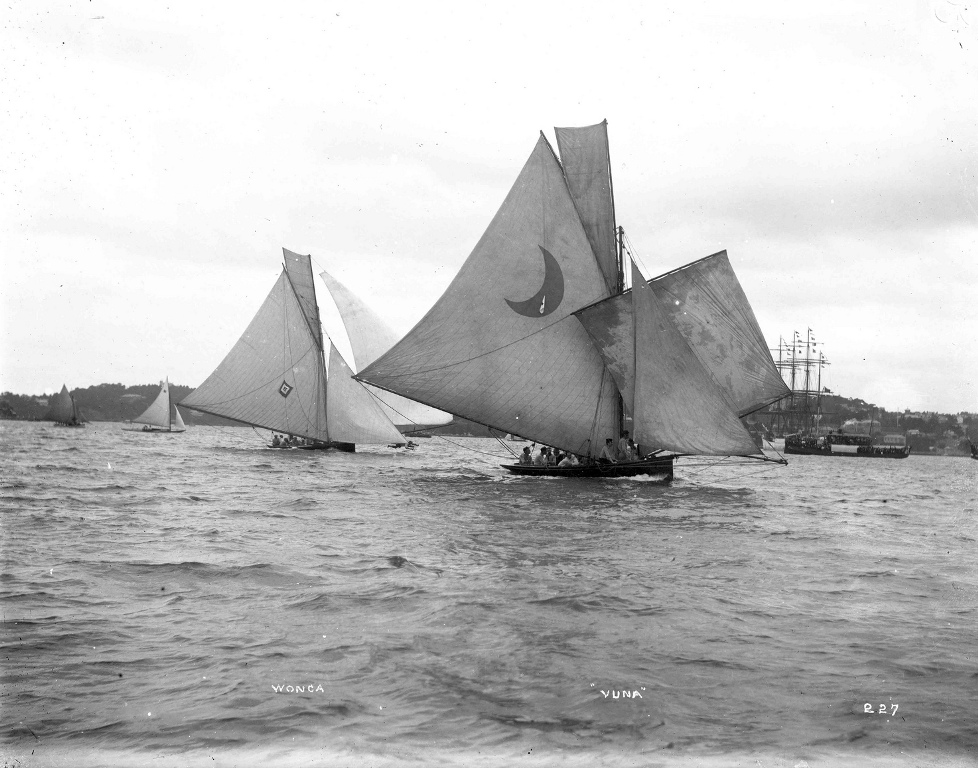
22 footers WONGA and VUNA (Varuna) on Sydney Harbour (see ferry packed with watchers to right in background) Object number 00013825, this photo is part of the Australian National Maritime Museum’s William Hall collection.
Port Jackson Pleasure Fleets - 5. and 6
The Building of Ships, Intercolonial Races, 22 Footers, 18 Footers and Mr Mark Foy
BY LANYARD.
It may be asked where was the mosquito fleet all this time; what were the 'kids', doing with their canvas dingeys. The canvassers were the cradles of the successful sailing men of to-day, and some of the boats were really no bigger than a cradle. The youngsters built the frame-work of their tiny craft out of any odds and ends in the way of timber, they could pick up: the wooden hoops of casks often did duty as ribs; mother's clothesline supplied standing rigging and sheets; and those enamelled iron advertisements, which proclaim the virtues of Dr. So-and-so's pills or cough drops, made splendid fins or centreboards. Mother could generally be counted on for the sails, and the calico skin was acquired somehow or other. Out of Berry's Bay there sailed one Saturday afternoon a merry crew of three little boys in their home-made dingey, with their lunch made fast halfway up the mast to keep it dry; they 'skited' as little boys will 'skite.' and they boasted, of the speed and weatherly qualities of their little bark. No millionaire in his palatial, steam yacht was prouder of his vessel; no millionaire half so happy. They moored in a snug little cove down the harbor; they scampered on the white beach; they bathed in the clear water, and then lunched in the shade of the sandstone rocks.
The nor'-easter was but half-hearted on the way home, and it died away altogether shortly after they had passed Pinchgut. Someone said something about a southerly 'buster,' but the urchin at the helm was not afraid of 'busters. 'Why, me and. 'Muzzy,' he said, scornfully, 'could bring her through anything.' The first puff heeled the dingey over, and she took a big drink over her gunwale; another puff, and she drank a deeper draught. The bailer was frantically at work, but the little boat, with fluttering sails, gradually settled down. On board H.M.S. Royal Arthur, a boatswain's mate piped a boat away, and the youngsters were soon taken on board, and sent forward, where kind-hearted tars' treated them to not cocoa and biscuits. When the time came to leave their new friends the little fellows pulled their forelocks to the spick and span officer of the watch:, and Muzzy, stepping forward, expressed his thanks for the rescue of 'me and my mates,' and a wish if ever the-Royal Arthur got into trouble; that they might be there to help.
One of the present members of the R.S.Y.S. tells of a canvas dingey that he and some of his companions built at Balmain, when they were children. With the hospitality which it is to be hoped is the characteristic of all yachting men, they yielded to the request of an admiring little boy to take him for a “ride”. His sister stood on the shore assuring him that he would be drowned; and what mother would say, as he had his best boots on!
A boatbuilder came that evening to complain that the boat had been left on his skids, and that people might think he had built her, which so hurt the 'owner's feelings that he accepted an offer of 7s 6d from the butcher boy, who took the boat away on his horse, but space must be found later for the doings of the small fry.
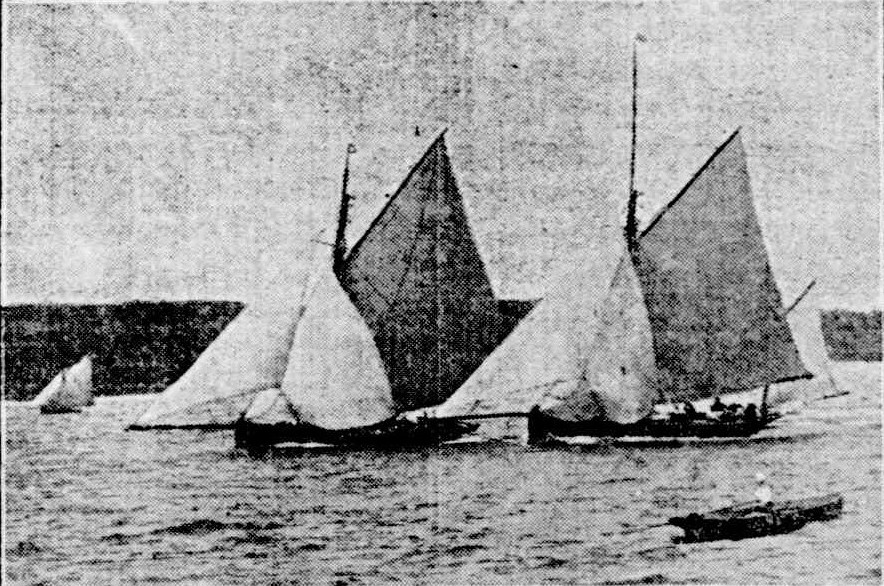
Waitangi and Electra.
A CHALLENGE FROM VICTORIA.
When the racing for first-class yachts was on the wane, the second and third classes were fairly busy. Jack Want's Longford-designed and built Guinevere, Mr. C. A. Benbow’s Harpy, built by George Ellis, Mr. Jackson's Violet, Mr. Knox's English designed Sirrocco, The Ione, the La Belle, the Doris, the Sao and the old Australian kept the pot boiling. The La Belle had been built by George Ellis, and was really an overgrown skiff, with a deck and a counter. A lump of lead on the keel was substituted for the centreboard of the skiff. She was undoubtedly fast and scored in the third-class. We now come to a very important period in Port Jackson yachting. A challenge from Victoria in 1886 awakened our first-class yacht owners. The public, whose faith in old champions is always strong, called for the Magic, but there were some who knew a little more than the public, and were not satisfied that the old boat could uphold the supremacy against Sir William Clarke's Janet. Mr. Alfred Milson commissioned Mr. Walter Reeks, a young English designer, fresh from home to put the Waitangi into shape. Persons passing Langford's shed In Berry’s Bay wondered what was being done to that boat. “They're chopping up- half her bottom for fire wood, and padding out the rest like a woman’s figger” said one. “They’re putting plumpers on her.” Said another, “you know what plumpers are; Innthorn-jawed women used to wear them to make their cheeks look plump.” ''She never was much good,” said a third, ''but she’s done for now.” and so on. It is strange how anything like a new idea is resented by the watersiders but are never they the slightest bit abashed when the idea comes off – they knew all along.
The Janet arrived in due course from Melbourne, and in the test races, which were all keenly watched by the public, sailed second to the Waitangi, whilst the Magic finished last, a very novel position for the old champion.
A FORTY-TON CUTTER.
Pleased with the success of the Waitangi, in her altered shape, Mr. Alfred Milson brought out the Era; (40 tons), from designs by Mr. Reeks. She was undoubtedly one of the handsomest yachts ever seen in Port Jackson, and was kept and run in faultless style. Many visitors to the colony were entertained on board by her owner, who besides being a keen and capable sportsman, has always been a charming host. If you bump up against a yachting man in England who has been in Sydney he is sure to inquire of Alfred Milson, and tell you of the jolly time he had on board the Era. She completely out classed the old boats, but there was on the stocks a vessel, also after Mr. Reeks designs, that was to give the Era some hard races and an occasional beating. The races between the Era and the Volunteer, will long be remembered by those who take an interest in yachting in Port Jackson. At the Centennial International Regatta, in Hobson's Bay, this State was represented by the Era, and the Volunteer. The Miranda left for Melbourne about the same time as the Era and the two yachts met in Twofold Bay, the latter having made the faster run down the coast. She was able shortly afterwards to take refuge, in Waterloo Bay, whilst the Miranda met the full force of a violent southeast gale, and after three days combat with it, during which she lost her supply of fresh water, and sprang a serious leak, it was decided to bear away for Eden. For a couple of days the ship's company had only soda water and whisky to drink, a state of affairs that was really worse than might appear to some, for there were several teetotallers in the crew. Jack Want was not on board; he was then looming big in the political world, and his increasing practice at the Bar made it difficult for him to devote much time to yacht racing, though he frequently continued to spend a week-end on the water.
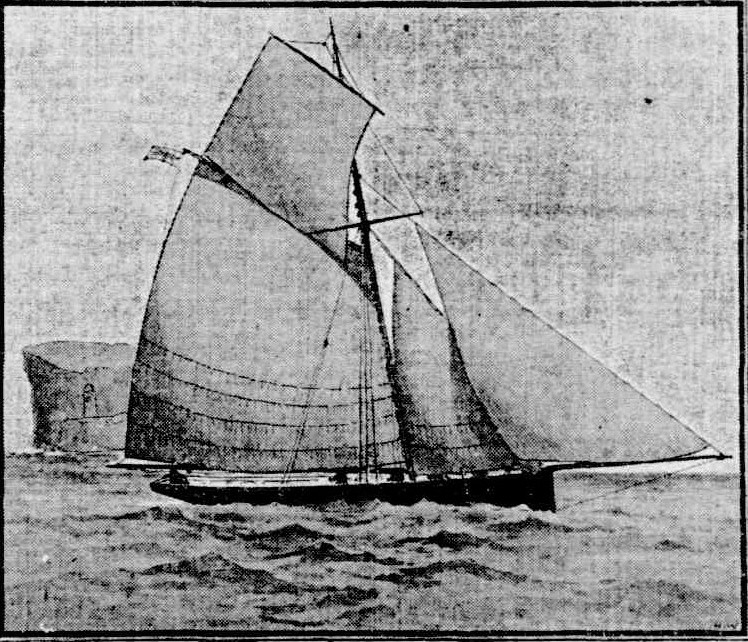
Mr. Milson’s Era.
THE BULLY OF THE ROAD.
It was on one of these trips that he was nearly run down by a carelessly-steered steamer, and he expressed his feelings by styling her the bully of the road. The late Mr. Justice Windeyer, who was one of his guests, was rather taken with the epithet, and when Jack Want appeared in the Vice- Admiralty Court next day for a steamer, that had run down a sailing vessel, his Honor did not hesitate to refer to the former as the bully of the road. “He can thank me,” muttered the learned counsel, “for teaching him that word.”
But if the owner was not on board the Miranda of the memorable voyage, his boon companion, Mr. Jack Macdonald, represented him, so, though she had to give up the attempt, we can rely that no effort was spared to get the big centreboarder to Melbourne. The little Assegai arrived too late for the regatta. She also met with rough weather, and for two days her crew were without fresh water. On the first day the Iduna, a Reeks designed Sydney built boat, which was then a Victorian representative, gained first place on her time allowance in the race for yachts 20 tons and upwards, the Era and Volunteer being second and third, but owing to some mistake about the course the race was ordered to be re-sailed, with the result that the Era won and the Volunteer took second prize.
The Akarana, from .New Zealand, won the race for yachts between 5 and 10 tons; she afterwards came to Sydney, where she was the pioneer of the successful invasion of our waters by New Zealand yachts. Sir W. J. Clarke, with a view to afford the Assegai a chance of a race after having gone so far, gave a trophy, which, however, a Victorian yacht won. If there is one thing the Sydney sailing man is proud of, it is the centreboard boat of local design and build. On her own waters she has, except when occasionally taken down by a Queensland boat of similar design, held her own against all-comers On other waters she does not appear to be so happy. The story of the defeat of Mr Mark Foy’s Irex in England by the Maid of Kent is sad reading, and at the regatta in Hobson's Bay Mr Paul’s Varuna could get no nearer than third, while the late Mr. M'Murtrie's Ellie was unplaced. Shortly afterwards, Mr. P. W. Creagh's Aileen was badly beaten by the Victorian Mayflower, a boat that afterwards figured unsuccessfully in Port Jackson, under the name Kanahook. The writer has no wish to decry the undoubted qualities of the local boats, and, if he occasionally touches a minor key, it is to remind some of our younger boating men that there are good boats, good builders, and good sailing men elsewhere –
(To Be Continued,)
Illustrations: Waitangi and Electra. Mr. J Milson’s Era.
PORT JACKSON PLEASURE FLEETS. (1907, November 9). Evening News (Sydney, NSW : 1869 - 1931), p. 3. Retrieved from http://nla.gov.au/nla.news-article113897607
What diamonds flash in every splash that drips upon my brow;
She knows she bears a soul that dares, and loves the dark, rough sea,
More sail, I cry; let, let her fly this is the hour for me.”
The 22-footer is a marvellous production of the local builders and designers. Built of half Inch red cedar with bent hickory or spotted gum ribs and keel, stem and stern-post of hardwood, she is, as she must be, a triumph of strength combined with lightness. Roughly speaking, her beam is from 10ft to 11ft, and her depth not more than 2ft 6in. Mr. Taylor's Keriki, one of the last of her type, measures from the fore end of her bowsprit to the latter end of her boom exactly 59ft 6in, her jib is 22ft on the foot, her mainsail 36ft on the boom, 22ft on the hoist, 22ft on the gaff, and 40ft on Ate after leech The ringtail is 5ft on the yards, and 39ft on the after leech, ner spin naker Is 2ft on the joist and 40ft on the boom, and her topsail yard is 21ft. To carry such a spread of canvas in so relatively small a boat without an ounce of ballast, some 15 to 25 hands are required, and pretty smart hands they must be.
These boats are without exception varnished or polished and, notwithstanding their great beam, look extremely graceful under canvas, whilst for excitement, no sailing we have had in this part of the world, has ever come up to that of the 22-footers with their professional or amateur skippers and crews, but the expense of running such boats has killed the class.
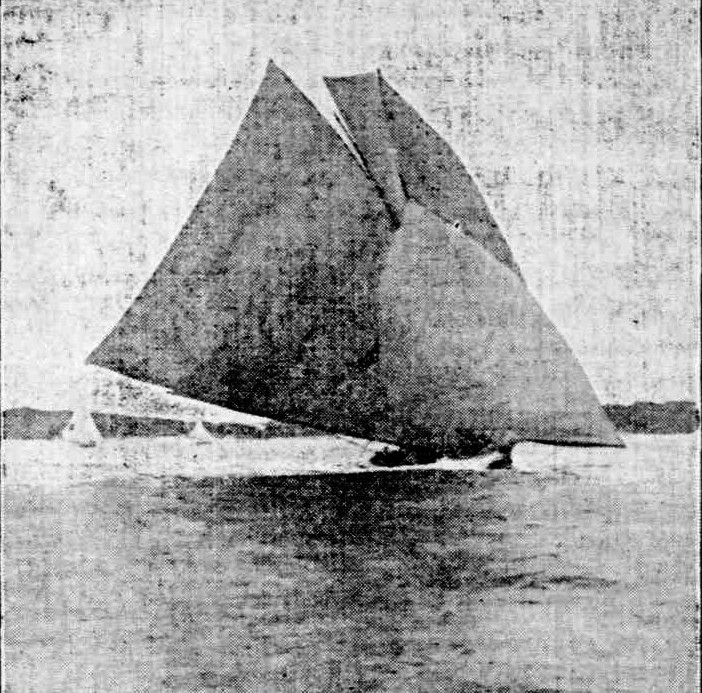
The Keriki.
The Brisbane sailing men brought their twenty-twos to Sydney, and there were return visits. So far as championships are concerned, they won out one, and that on their own waters in a Sydney-built boat, but they shook up the local talent, and carried away several first prizes in other events.
TABLE OF INTERCOLONIAL CHAMPIONSHIPS.
Year Sailed at Boat. State. Builder.
1894 Brisbane. Irex N.S.W. Donnelly
1895 Sydney. Esmeralda N.S.W. J. Hayes
1896 Brisbane. Caneebie Q . . . . Golding
1897 Sydney. Irex N.S.W. Donnelly
1898 Brisbane. Effie N.S.W. Donnelly
1899 Sydney Effie N.S.W. Donnelly
THE INTERCOLONIAL CHALLENGE RACE, 1897.
Of the hundreds of races sailed by the 22 footer class, perhaps the most exciting was the Intercolonial Challenge Race, sailed at our Anniversary Regatta in 1897. The Bulletin, Caneebie, Ettie, Stanley, and Hibiscus represented Queensland; the Vigilant, Gladys, Irex, Wonga, Effie, Flying Fish; Figtree, Esmeralda, Latona, Ettie, and Lillian represented New South Wales. It was a squally day, and the crews had hard work at times to keep their boats afloat. A heavy squall from the north-west just after the start did not, however, prevent the hoisting of balloon Jibs, and the boats tore down towards Bradley’s to meet with a shift of wind, which now blew from the north. The Vigilant was the first to pass that headland, followed by the Bulletin, Fig Tree, Gladys, Wonga and the rest of that fleet. Then came trouble. A squall from the nor’east seemed to mow down the boats, the Effie lost her mast, Figtree her bumpkin, and the Wonga treated her crew to a bath. Shortly after the squall, the Vigilant, Gladys and Bulletin were in the van. Another change of wind, and the Bulletin led. The race now resolved itself into a contest between that boat and the Vigilant, which went in hot pursuit, and passed her rival, leading at the Manly buoy by 14 seconds. The other boats were four minutes and upwards behind at this point. The usual kites were set at this point for the run home, but the Vigilant’s were prudently taken in while crossing between the Heads.
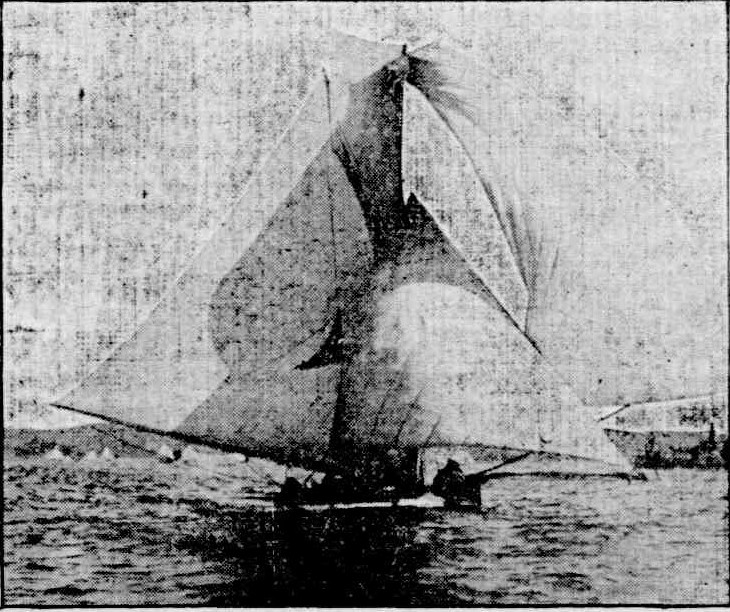
The Effie.
Caneebie, that had been giving Irex a great race for third place, had her mast blown clean away out of her; and the skipper of Vigilant, whose mast had been sprung in one of the squalls, played for safety at the Shark Island buoy, and instead of gibing, put his helm down. Whether the crew were taken by surprise, or there was some misunderstanding, the sheets were not brought in fast enough. The skipper of Bulletin saw his chance, and threw his boom over. It was an anxious moment when the boat heeled over, but she righted, and sped, with a good lead towards the flagship. On the beat to Fort Denison she drew out further from Vigilant, but all was not over yet. The two leaders, owing to shifts in the wind and a calm, changed places, and it was even money till the line was crossed by Bulletin to the accompaniment of the wildest cheering, a few: seconds only ahead.
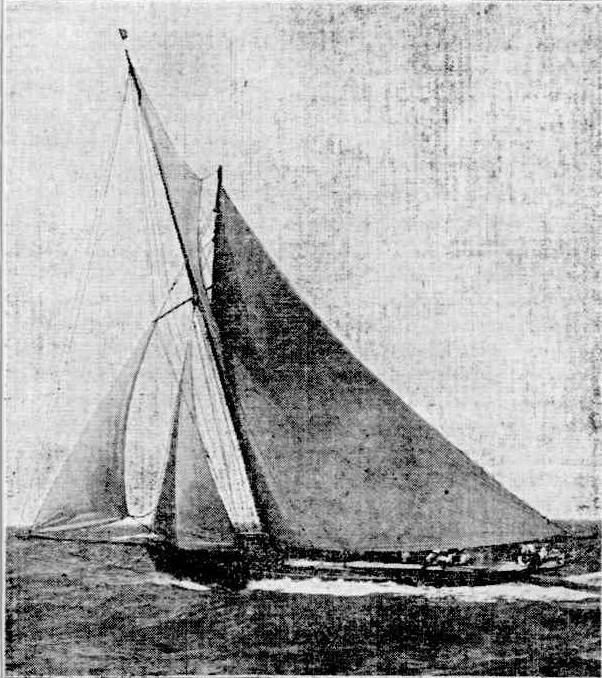
Mr. Alfred Milson’s Era.
THE COMING OF MARCUS.
Mr. Mark Foy, the lavish patron of open-boat sailing, made things boom. The big fields and splendid contest were practically due to his organisation and liberality. Though some of his ideas bumped up against those of conservative and. more dignified sailing men, he must be classed as a sportsman. He never would allow the name of Foy to be tarnished by the entering of a protest; he did not avail himself, as some men would have done, of the opportunity of advertisement his connection with the sport gave him; he was a cheerful loser, and by no means an aggressive, though an enthusiastic winner.
One of his ideas was to keep the boats in sight of the starting point, Clarke Island, during the whole of the race, and by having sails of different colors, or large colors or designs on the sails, make it possible for the uninitiated to distinguish the different boats. Both the colored sails and the designs met with strong opposition in many quarters, and the Anniversary Regatta committee made it a condition that the boats should not carry such disfigurements. The open-boat owners stuck to Mr. Foy, and refused to take the colors off their sails— in some cases the designs were stained in— and Mr. Foy held an opposition regatta. Next year the Anniversary Regatta committee had to yield, and certain classes of boats still disfigure their sails by huge designs in primary colors.
Mr. Foy was the founder of the Sydney Flying Squadron, a club where amateurs and professionals compete against each other; and it must be admitted that it has done and is still doing good work, even if it violates the canons of yachting taste in the garb of the crews and the carrying of the objectionable colors on the sails. 'Call that a sail! Why, I thought it was an illuminated address,' said one disgusted yachtsman. If the reader wishes to spend a pleasant afternoon in summer, let him moor his boat off the southern end of Shark Island and await events. He will enjoy the cool sea breeze after the heat and dust of the city, and a delightful feeling of drowsiness will overcome him till the long procession of boats begins. Then the fun will keep him awake. Whatever the course the racing yachts and boats may have gone, they all have to round the buoy at Shark Island, and gibing there presents possibilities, nay probabilities, of capsizes and collisions. It is a treat to see the crews overhaul the fatal buoy and set their kites.
EXCITEMENT RED HOT.
But if the reader wants red hot excitement let him get a seat on board one of the 22 or 18 footers in a race. There will be some difficulty about that; most of the boats have their regular crews of experts. But for the sake of argument let us imagine that he has been taken on board the 'Sudden Jerk' (22 feet) as a 'pick-up' just before a final heat. He will find a rough and ready ship's company of some 20 men and youths, who strike him as a most undisciplined mob. They swop pleasantries with their friends and acquaintances on the crowded steamers that are to follow the race, and they indulge in pointed remarks with their opponents. One man alone is silent. Nobody seems to mind him; he is the skipper. As the time for the start draws nigh the babel of voices ceases — order comes out of chaos. The skipper is counting the seconds — he spurns a stop-watch; and evidently his computation of time is correct, for he charges across the line simultaneously with the fall of the flag. He has no need to call out, as some skippers do, when a puff strikes the boat; the crew, seated on the weather gunwale, automatically lie out; and the odd men, who are seated between their knees, throw themselves out on top of them. The reader is unfortunately in the lower layer, and finds a 16-stone man on his bread-basket!: 'Sacks on the mill' is nothing to it. The puff is a weatherly one; the jib is eased, and the skipper takes a valuable luff out of the boat; the jib is brought in again as the wind heads the boat, and he bears away and luffs again when the opportunity offers, the crew sliding in and out as occasion requires.
The spray is coming over near the weather chain plates in swift showers, and despite the lee-cloths, a good deal of solid water finds its way into leeward. The bailer is busy with his big flat dish; he does not spare himself while he is at it, and only gives place to the relieving bailer when he is completely knocked out. The patent blocks on the main sheet sing merrily when it is eased in the squalls, and the skipper complains that the crew is not 'helping him enough.' He is a bearded veteran, with mild blue eyes. One of the sitters raises his head; it comes within the skipper's line of vision, and then there is an explosion and the offending head instantly goes back to its proper place. Its owner knows that tine tiller will be about if he does not keep it out of the way, for the skipper is explosive, as well as quiet. There is a wild scramble over the centreboard box, and the hanging-out battens when the boat is put about. Some are trampled on; but the reader has been quick, and again finds himself one of the lower layer of serried humanity. Perhaps he won't be so quick next time, so as to have a spell on top.
It is a relief when the buoy in Taylor Bay is rounded and sheets are eased for the lead to Shark Island. The big balloon jib burst from its stops and bellies big, lifting the boat's stem well out of the water. The skipper has now a couple of hands to help him with the tiller. Just ahead is one of the rivals, the 'Roaring Gimlet’, a mass of spars and sails; her crew appear to be seated in the water which boils above the shallow hull. At the Shark Island beacon the sheets are further eased, and the skipper of the 'Sudden Jerk' is evidently going for a lee overlap, at the rounding buoy. A number of boats in another race are making for the same buoy, and things are a bit crowded in its vicinity. A fool with half a dozen confiding girls has got his boat in irons to wind ward of the buoy; he is in everybody's way, and blessings, mingled with advice, are showered upon him. The 'Jerk' just scrapes past him. The 'Gimlet's' topping lift has already been hoisted, and her boom is being brought in for the gibe. The 'Jerk' still rushes on. Two of her crew are ready with the backstays; an other has the topping lift in hand, and the order, 'Jibe oh,' is given. The mainsail is being hauled in, and the crew is preparing to shift over. Over goes the 'Gimlet's' boom, and she shoots up, giving the 'Jerk' perilously little room! The latter's boom follows almost on top of the other boat, and; the 'Jerk' has the best position. She heels over, taking in a great deal of water, and hesitates at a dangerous angle; but the crew with a frantic effort lever her up and he water rushes with a swish to the other side of the boat. The spinnaker boom had been shoved out during the jibe, the big spinnaker bursting out almost simultaneously and neck and neck the two boats tear straight to the finish. 'No ring-tail,' volunteers the skipper; indeed, it is no day for one. It is nobody's race, and whilst the 'Jerk' does not lose ground, she does not seem to gain an inch. A steamer crowded with spectators, her sponson awash, is just to leeward, and the air is rent with shouts of advice and encouragement The boats rapidly approach the finishing line, and rush across it together. ‘Dead heat,' says someone 'Dead heat be___, it's the Gimlet!' says another — But the judge says ‘It’s the Jerk’ and he ought to know. The Jerk runs under the lee, and Babel breaks loose among her crew. A puff suddenlv comes round the island, and, catching them unawares fills the boat to the thwarts, but the puff is/ only momentary, and no harm ensues. The skipper takes the opportunity of expressing his supreme contempt for the crew, who, however, don’t seem to mind in the least, and nothing now remains to be done but to respond to the cheers from the other boats before running home. When the shed is reached a demijohn of tangle-foot is bought from the nearest Inn, and the reader is invited to take a swig. He can, of course, please himself but he will be tired enough and thirsty enough to drink anything.
BOOKMAKING.
Sailing has always been considered a clear sport, and for many years the bookmaking element had been absent. Shortly after the formation of the Flying Squadron, the bookmaker and his genteel penciller, made their appearance on board the steamers of that club, which, like some of the other open Boat clubs, looked to gate money to augment their prizes. The Dook wants ammunition, and by__ he shall have it.' The public wanted to put a bit on their fancy, and the Flying Squadron afforded them the opportunity. The Johnstone's Bay Sailing Club did their best to stop bookmaking on board their steamers, but the gentle men with leather lungs and leather bags were too strong, and were eventually allowed by that club to ply their calling within certain restrictions. Outside these two clubs, however, they were never a material element, and admission to the steamers of the R.S.Y.S., the P.A.Y.C., and S.A.S.C being only by invitation, those clubs have always been free from what cannot be considered but an undesirable element. A fellow who had been to some horse races insisted that he had been to a regatta. 'They were all pulling races, you know'. It is fair, however, to say that book making has never been known to affect the result of a single sailing race. Recent legislation, if properly administered, should leave the bookmaker high and dry on shore, where all true sailing men hope he will remain.
(To Be Continued.)
Illustrations : The Keriki. Mr. Alfred Milson’s Era. The Effie.
PORT JACKSON'S PLEASURE FLEETS. (1907, November 16). Evening News (Sydney, NSW : 1869 - 1931), p. 11. Retrieved from http://nla.gov.au/nla.news-article113901086
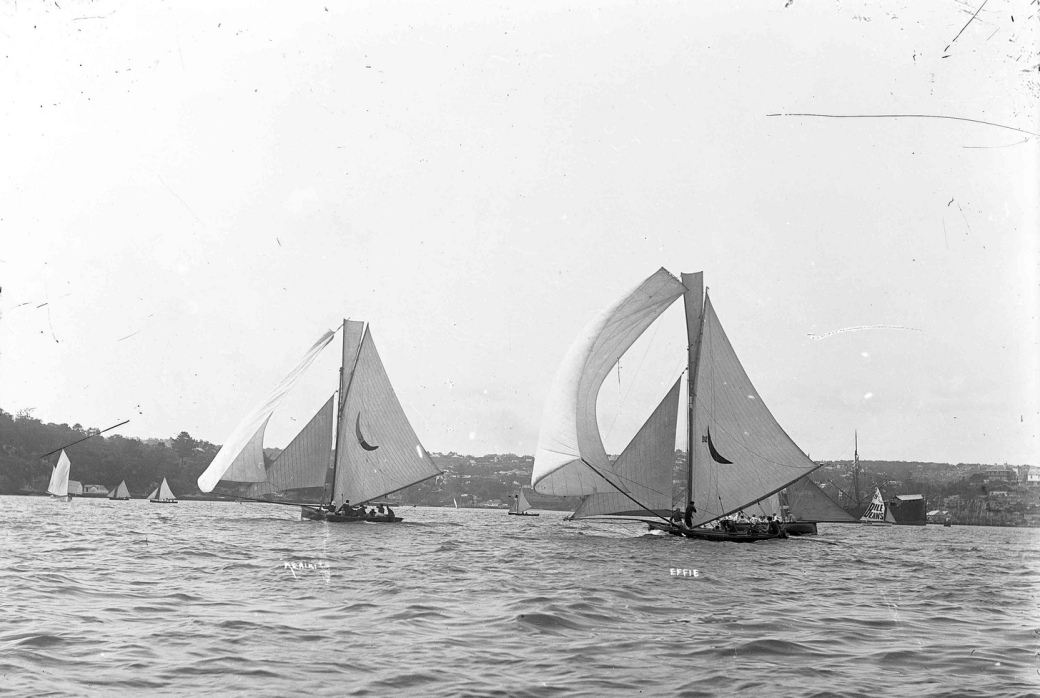
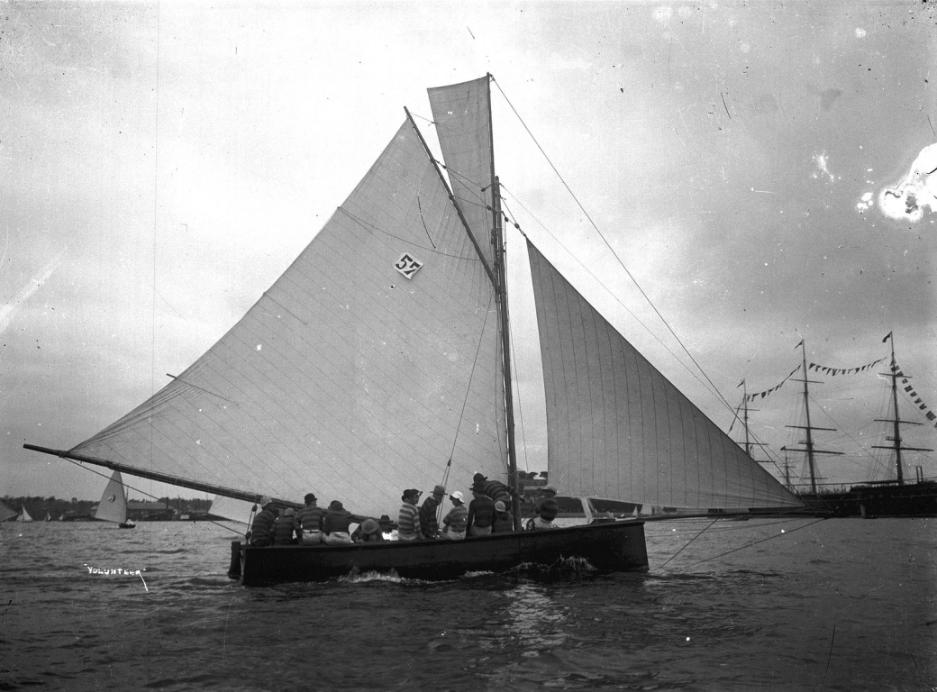
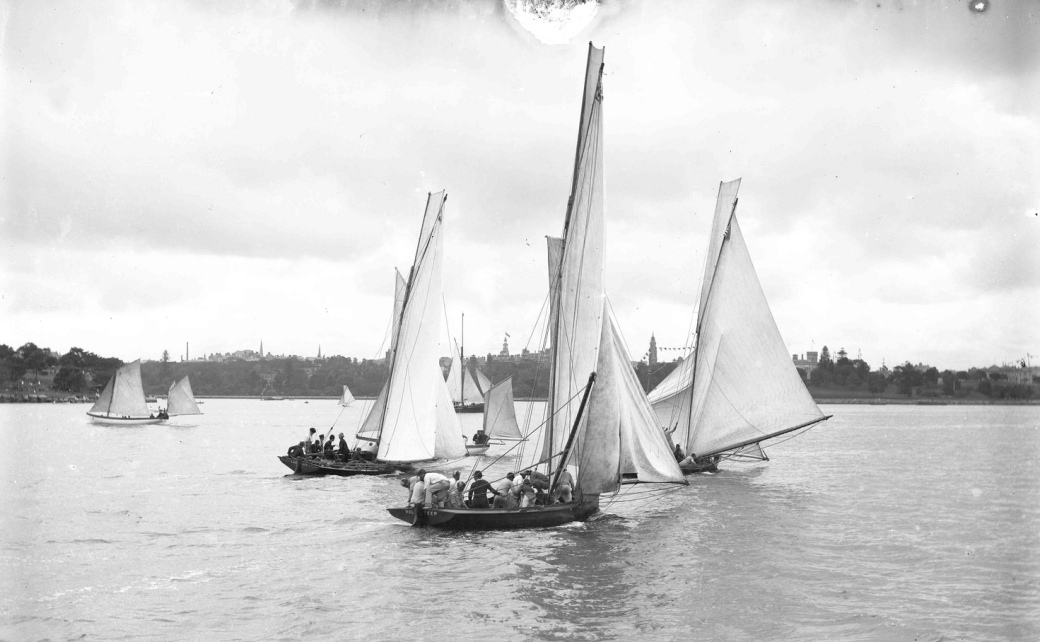
Extras:
HMS Royal Arthur was a first class cruiser of the Edgar class, previously named Centaur, but renamed in 1890 prior to launching. Royal Arthur, and her sister ship Crescent, were built to a slightly modified design and are sometimes considered a separate class. She was built at Portsmouth and launched on 26 February 1891.
She first served as the flagship of the Pacific Station from 1893 to 1896, before being refitted at Portsmouth in 1897. She then served as the flagship of the Australian Station from 1897 to 1904. In that role she provided escort for the Royal Yacht Ophir carrying the Duke and Duchess of Cornwall and York (the future King George Vand Queen Mary) to Australia to open the new Federal Parliament in 1901. She left the Australia Station on 6 April 1904 and was paid off and refitted at Portsmouth.
She recommissioned in 1905 and served on the North America and West Indies Station before returning to England in 1906. Laid up in reserve for three years, she served as part of the Home Fleetand later Queenstown Training Squadron. She was a guardship at Scapa Flow during the early part of the First World War and later as a submarine depot ship. She was paid off in 1920 and sold in August 1921 for breaking up in Germany.
HMS Royal Arthur (1891). (2014, May 27). In Wikipedia, The Free Encyclopedia. Retrieved from http://en.wikipedia.org/w/index.php?title=HMS_Royal_Arthur_(1891)&oldid=610326134
JOE DONNELLY. FAMOUS BOATBUILDER RETIRES. A MAKER OF CHAMPIONS.
Few names are better known in Australian aquatic circles than that of Joe Donnelly, the veteran boat builder... JOE DONNELLY. (1914, January 2). Evening News (Sydney, NSW : 1869 - 1931), p. 2. Retrieved from http://nla.gov.au/nla.news-article114502719
DONNELLY BENEFIT.
Sixteen entries have been received for the 18ft handicap to be sailed on Saturday for the benefit of the veteran boat-builder, Joe Donnelly. They are as follows: - Keriki, Livonia, Ronia, Mona, Sunny South, Desdemona, Advance, Vision, Scot, Australian, Lilian, Zena, Donnelly, Ben-my-Chree, Nimrod, and Oweenee. The course chosen is twice round the Flying Squadron's triangle, and the prizes will be trophies, presented by Messrs. C. B. Nichol and B. De Groen, and Dr. Elliott. SAILING. (1910, April 8). The Sydney Morning Herald (NSW : 1842 - 1954), p. 11. Retrieved from http://nla.gov.au/nla.news-article15116769
EARLY MOSMAN. Picturesque Period. WORK OF RICHARD HAYES HARNETT.
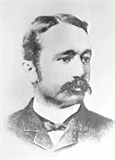 Mr. R. H.
Harnett, of Chatswood, was with his father, the late Richard Hayes Harnett, on
the day when the Duke of Edinburgh was shot at Clontarf. The incident, he said
yesterday, caused the wildest excitement, and it was only by a desperate effort
that the would-be assassin was saved from being hanged to the nearest
tree.
Mr. R. H.
Harnett, of Chatswood, was with his father, the late Richard Hayes Harnett, on
the day when the Duke of Edinburgh was shot at Clontarf. The incident, he said
yesterday, caused the wildest excitement, and it was only by a desperate effort
that the would-be assassin was saved from being hanged to the nearest
tree.
This, however, was but one event In the remarkable career of the "Showman of the Shore," as Richard Hayes Harnett was affectionately known in Sydney in the days when Mosman was mostly bush. Recalling that picturesque period, Mr. Harnett, "Junior," as he likes to be styled, notwithstanding his 88 years, said that nearly half the land in the district had once been owned by his father, who had been a man of considerable force of character, imbued with progressive ideas.
PIONEERING ENTERPRISE.
On his arrival in Sydney in the fifties (he originally came to Australia from Cork in 1840 by the ship China), Richard Hayes Harnett opened up business as a commercial broker. Inheriting, some years later, a very large fortune, he bought in 1870 some 450 acres of land at Mosman and Cremorne, and more than 1000 acres at Longueville and Chatswood.
The Mosman and Neutral Bay wharves were built by him in 1872, and he established the Mosman and Neutral Bay ferry at his own expense. The first boat was the Aberlona, and the second, Golden Rose. About 1877, again drawing from his own pocket, he started the first line of buses from Milson's Point to Mosman, Chatswood, Longueville, Pymble, and Middle Head, thus pioneering the way for the North Shore railway. He was even able to induce the Government of the day to make a trial survey for a harbour bridge.
In addition to giving free land for churches and parks, and building the first Public school at Mosman, he erected a beautiful mansion of 22 rooms, called Buena Vista, at the junction of Bradley's Head Road, 'Middle Head Road, and Military Road. Parts of the old house may still be seen behind the present Buena Visa Hotel.
A NOTABLE YACHT.
"My father," continued Mr. Harnett, "made yachting history with his remarkable boat, Australian, whose lines were adapted from a fish.
"He caught a mackerel in Woolloomooloo Bay, and, to obtain the lines that he wanted for his yacht, took the fish to his house in Victoria Street. Opening its mouth, he cut it in two parts, and proceeded to trace its lines on paper. From the design thus obtained he built the yacht, which won the race in the Regatta of 1863.
"He was appointed first commodore of the Prince Alfred Yacht Club in 1868."
A LONG ROW.
When the Harnett family first went to live on the North Shore, in 1860, there were no more than a thousand dwellings there, and all these were without water, gas, and sew-erage. For water, the residents depended either upon the rainwater flow from the roofs or on creeks. Fruit drays used to come down early in the morning to a spot where the Pacific Highway is now, and often they were compelled to wait until evening to cross the water. That was the time when the Harnetts, father and son, thought nothing of rowing to Circular Quay, though there were occasions when they were given "a friendly tow." It was not to be wondered at, therefore, that when a ferry service was eventually instituted, passengers did not cavil at paying a fare of one shilling return. Even at that figure the venture was unprofitable.
Mr. Harnett mentioned that the cost of constructing roads at Mosman, between 1870 and 1882, devolved upon his father, except in the case of Military Road. Indeed, some £40,000 had come out of the estate for these and other public works, during that halcyon period, when the property was the largest in Mosman in single private ownership.
Despite his influence and wealth, however, Richard Hayes Harnett had no taste for public life. He was content to put Mosman "on the map" and to live up to his reputation as "The Showman of the Shore." EARLY MOSMAN. (1937, September 21). The Sydney Morning Herald (NSW : 1842 - 1954), p. 10. Retrieved from http://nla.gov.au/nla.news-article17407707
DEATH OF MR. RICHARD HARNETT.
Mr. Richard Hayes Harnett, a colonist of upwards of 60 years, died on Saturday afternoon at his residence, Comeen, Orchard-road, Chatswood, at the age of 82 years.
Mr. Harnett was a native of Cork, and in 1840, when a young man, arrived in this State in the sailing ship China. After a short stay in Sydney he visited Maitland, and then Wellington, where he passed some years in pastoral pursuits. Returning to Sydney, Mr. Harnett entered the old firm of Row and and Co., general merchants, and shortly after started business in Hunter-street as a commercial broker. Deceased was perhaps best known as one of the pioneer settlers on the North Shore, and in 1871 he entered into partnership with the late Sir Alexander Stuart, with whom he was associated in opening up the whole district. He first resided at Blue's Point in 1847, but removed to Gore Hill in 1861, where he remained until 1872. In that year deceased removed to Mosman. Mr. Harnett started the first ferry service which ran to Mosman, and also controlled two lines of omnibuses running in the district, the one to the fortification at Middle Head and the other to Chatswood and Pymble, then almost bush land. When Mr Harnett first settled at Mosman there were but few residents there. Until 1884 he made the roads that Mosman possessed, and owned there a large quarry, whence some fine stone was hewn for Sydney and Melbourne buildings. He also constructed the first wharf at Neutral Bay. Deceased became second Mayor of Willoughby in 1868. He was at one time connected with the Pyrmont Brewery and the Hall of Pharmacy, King-street. Mr. Harnett assisted in the movements that secured the Milson's Point railway and the tramway services on the north side of the harbour.
As a yachtsman Mr. Harnett was well known, for he acquired a name in the early days as a skipper and designer. It was he who in 1867 designed and built the old Australian, which was launched at Woolloomooloo in that year. She was of the present type of craft, and was looked upon at the time as a remarkable boat; but so impressed was Mr. Harnett with the merits of his design that he gave the lines of the boat to the late Mr. George Thornton in 1868, who took them to England, where they were accepted by a firm of builders. Amongst many of his yachting friends and rivals were the late Messrs. Alfred Fairfax, Isaac Josephson, and F. J. Jackson. Mr. Harnett was an original member of the Prince Alfred Yacht Club, was one of the promoters of the Anniversary Regatta, and was connected with other sailing clubs. Of the pioneers of yachting in Sydney Mr. James Milson is now the sole survivor, but up to the time of his death Mr. Harnett shared with him that honour.
The funeral took place on Sunday, the internment being made at St. Thomas' Cemetery, North Sydney, the service being conducted by the Rev. S. H. Childe. It was of a private nature. The chief mourners were :-Messrs. R. Harnett, Rolla Harnett, Cecil Harnett (sons), J. W. Gibson and H. G. Cambridge (sons-in-law), and Lawrence (nephew) ;and amongst the few friends present were Messrs.E. J. Sievers, H. C. Catt, H. Finn, C. Ludowici, L. Finn, P. Dettman, C. Wilcox, D. Murphy, N. Dowling, and J. McLean. The funeral arrangements were carried out by Mrs. P. Kirby and Son. DEATH OF MR. RICHARD HARNETT. (1902, November 18).The Sydney Morning Herald (NSW : 1842 - 1954), p. 5. Retrieved from http://nla.gov.au/nla.news-article14505932
MOSMAN BAY - Fifty Years Ago.
(By H MACOURT.)
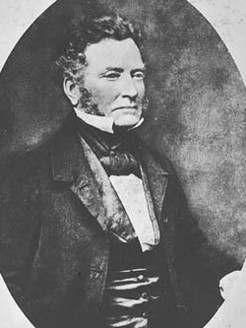 Early records
mention the careening of H.M.S. Sirius in 1789, and this was stated to have
taken place in a bay on the northside of the harbour which received the name of
Great Sirius Cove. Later Archibald Mossman erected a wharf there for the
equipment of his whaling vessels, and the name was changed to Mossman Bay, the
second "s" being dropped subsequently.
Early records
mention the careening of H.M.S. Sirius in 1789, and this was stated to have
taken place in a bay on the northside of the harbour which received the name of
Great Sirius Cove. Later Archibald Mossman erected a wharf there for the
equipment of his whaling vessels, and the name was changed to Mossman Bay, the
second "s" being dropped subsequently.
Right: Archibald Mosman (1799-1863), by unknown
photographer, courtesy State Library of New South Wales, GPO 1 -
17662
The passing years brought few changes to this picturesque spot, for in 1880, when the accompanying photograph was taken, bush covered slopes ran down to the water's edge, with only about half a dozen houses to be seen on the surrounding landscape. The whole population was less than 100. In 1887, the number was given as 300. From that time onwards the settlement was very rapid. Landowners of to-day would find difficulty in believing that in 1880, land there was highly priced at £60 an acre.
Mr. H. N. Colley, who went to the Bay 52 years ago, and still carries on business there, recalled the building of the old rustic bridge by Captain Blix and his two sons. They were assisted by a man named Angelo, employed by Richard Harnett, who had opened a quarry on the north-western side of the Bay in the late seventies. There was no ferry at night-time, and the bridge was needed to get across. The stone from this quarry was of specially good quality. Some of it was used for the Ryde railway bridge, and the wall fronting the Botanic Gardens, and more was taken to Melbourne for the erection of Wilson Hall, In the University there. At one time 200 men were engaged at the quarry. The bridge was subsequently chopped down. Rumour was that this was done because a well-known resident could not take his yacht to a wharf at the head of the Bay. To save the people on the other side the long walk round the top of the Bay, Mr. Colley ran a skiff ferry, charging passengers a penny, and three pence after 9p.m. Mr. Colley stated that Bloxsome bought the Rangers Estate, which contained 45 acres, for £45, and sold it at a later date to a syndicate for £45,000. Bloxsome's gardener's cottage can be seen at the top of the picture.
BUILDING OF MANY USES.
"The Barn," on the right of the bridge, was built by Archibald Mossman in connection with his whaling enterprise. It served many purposes since then. Harnett used It as a store-room. Later it became a dance hall, then a skating rink, and had fallen Into disuse when taken over In 1928 by the Boy Scouts Work-men in the vicinity occupied the cottages along-side "The Barn," and the cottage at the end of the footbridge was a licensed house for many years, first as the Bull and Mouth Hotel, and later at a wine shop "The Barn" is the only one of these places remaining
Newcomers to Mosman would find difficulty in associating the road In the picture with the present Avenue-road lined with houses, busy with traffic-tram and motor It is one of the things which indicate the rapid development which had taken place In a comparatively short time Harnett, who then lived at Buena Vista, on Military-road claimed that Avenue-road was a private thoroughfare, and Mr Colley remembered a gate across It nearthe cottages which he had to lock each night The next house on the road was The Ranger'sLodge, situated near the Waterfall Harnett when he drove down to the bay, put his horse In a little stockyard near Colley's boatshed while he went to the city ferry boats ran Intermittently before the eighties In 1881Jeanneret began running an hourly service Athol Gardens was then a picnic ground There was also a recreation place at Cremorne
Cremorne Point with Its huge flats and commodious residences and every side of Mosman Bay completely occupied by houses, appear far removed from this picture The change serves to illustrate the rapid growth of Sydney and suburbs in the last half-century Probably Mr Colley and Mr W E Wilson are the only present day residents of the Bay who were there in the eighties. MOSMAN BAY. (1934, January 13). The Sydney Morning Herald(NSW : 1842 - 1954), p. 11. Retrieved from http://nla.gov.au/nla.news-article17039970
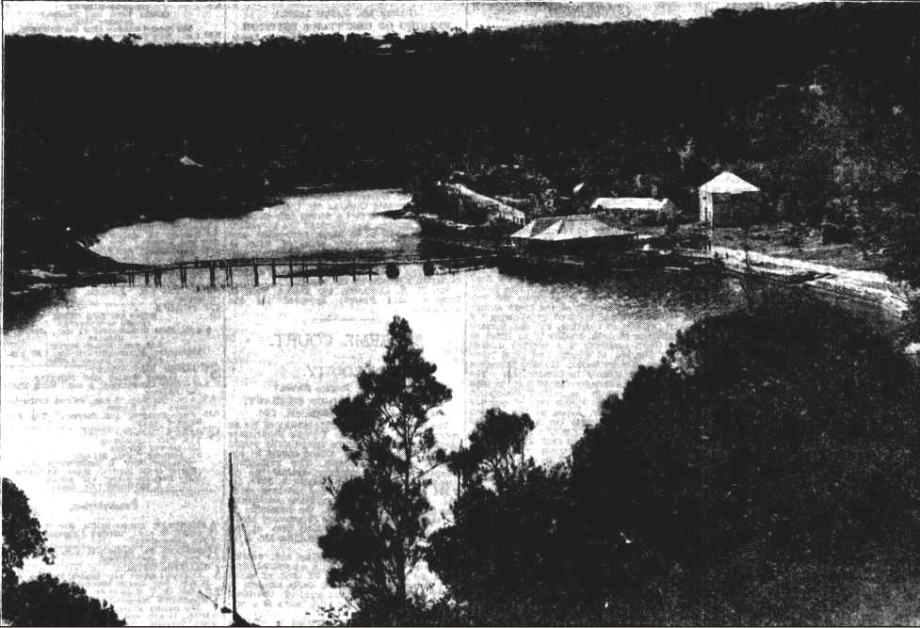
Picture: THE QUIET RETREAT OF MOSMAN BAY IN 1880. "The Barn," seen to the right of the bridge, was built by Archibald Mossman. It ia now occupied by the Boy Scouts. THE QUIET RETREAT OF MOSMAN BAY IN 1880. (1934, January 13). The Sydney Morning Herald (NSW : 1842 - 1954), p. 11. Retrieved from http://nla.gov.au/nla.news-article17039909
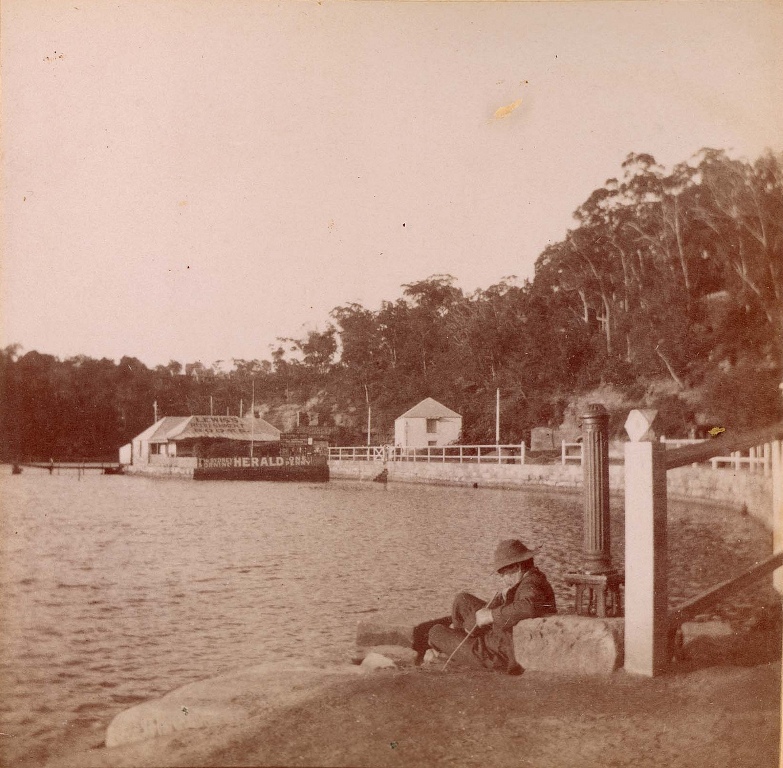
Mosman Bay, Sydney 1879
- Object number 00036455_22, courtesy Australian National Maritime Museum; This
image is from a leather photograph album dating to the late 1800s. The album
contains sepia prints of a voyage from Melbourne to Sydney on SS ARAMAC as well
as various sights around Sydney Harbour and the Hawkesbury River. The provenance
of the album and the identity of the photographer is
unknown.
CECIL S. HARNETT COLLECTION: Cecil Stanley Harnett (1879-1956) was the son of Richard Hayes Harnett Jnr, mayor of Mosman.
Little is known of Cecil Harnett. He was a serious amateur photographer active between 1915 and 1930, often published in photographic magazines and awarded competition prizes.
Harnett Collection: c1915-1923; over 900 items. Views of northern beaches and greater Sydney, family scenes, general NSW. Glass and film negatives, photographic prints. Catalogue available for reference [Macleay Museum, 1987] HP85.9, c1910-1930 approx. 1500 items Views of northern beaches and greater Sydney, family scenes, general NSW. Glass and film negatives, photographic prints; Donated by Stanton Library Listing available for reference. HP89.4
CHATSWOODHenry Lawson
(1918?)
“Twas an old respected settler, in the unrespected days,
Who had land along the North Shore and – we’ll say his name was Hayes;
And he came there as a young man, when great work was to do,
And his young wife’s name was “Chattie” (and, no doubt, she chatted, too).
‘Twas a “small place in the country”, where they went to be care free,
Out beyond the pleasant suburb that they now call Willoughby;
And a little wood was on it, and the trees were tall and good,
And his young wife used to dream there, so he called it “Chattie’s Wood”.
“Chattie’s Wood” has long since gone, and shops are standing in a row
Where the young wife went a-dreaming in the days of long ago;
How the pretty name was altered doesn’t matter anyhow;
But the wife is still remembered, as they call it Chatswood now.
(Appeared in Lone Hand 1st February 1919)
Charlotte Mackenzie of Melbourne married Richard Hayes Harnett Snr in 1869. The Harnett family owned Valetta House at Gore Hill. This was Harnett’s second marriage.
DEATH OF THE HON. S. H. HYAM, M.L.C.
News was received in Sydney last evening of the death of the Hon. S. H. Hyam, M.L.C., which took place yesterday at his residence, Woodlands, Katoomba, at the age of 64 years. The late Mr. Hyam was a native of New South Wales. He was born at Jamberoo, in the Illawarra district, in May, 1837. His father was one of the early settlers, having arrived in Sydney by the merchant vessel George Canning in the year 1828. After receiving a liberal education by private tuition, young Hyam, at the age of 19 years, went to Melbourne, where he spent some time in acquiring a knowledge of the practical part of mercantile affairs. He then returned to New South Wales and completed his commercial training in Sydney. Mr. Hyam married a daughter of the late Samuel Priestly, and he subsequently joined his father-in-law in business as produce merchants. In 1874 Mr. Hyam opened up a similar business on his own account in Sussex-street, which he successfully carried on for a number of years. In the same year that he commenced business on his own account, he also started his career as a public man by being elected an alderman of the Borough of Balmain. He was also elected Mayor of the district. In the same year he was appointed a justice of the peace, and for some years he was on the regular roster both at the Central and Water Police Courts. After serving the borough of Balmain in the dual capacity of Mayor and alderman for four years, Mr. Hyam, in order to give more attention to his rapidly increasing business, found it necessary to retire from public life ; but in 1885 the electors of Balmain selected him as their Parliamentary representative, he being returned to the Legislative Assembly by an overwhelming majority. Among the measures which Mr. Hyam was successful in having passed through the House were the Balmain Tramway Bill and the Board of Settlement Bill. He also took an active part in regard to the Fisheries' Commission, of which he was a member. He was subsequently elected a member of the Upper House. He had a full know-ledge of pisciculture and growth of oysters. Mr.Hyam was appointed a member of the Royal Commission to inquire into the workings of the liquor traffic. He was also appointed a member of the Public Works Committee. He took an active part in the work of advancing the agricultural interests of the State, and at onetime he ranked high as a breeder of pure Jerseycattle. As a sporting patron, he was well known,and in this respect Mr. Hyam was a thorough Australian Cricket, football and lacrosse circles welcomed him cordially, but his specialty was aquatics. He always took an active part in arranging inter-state contests, and his boats, Lottie, Carlotta, Ettie, and Florrie, were among the best-known in our waters, and he himself was regarded as one of the leading patrons of aquatics in Australia. Lord Carrington, on one occasion, referred to the deceased as the father of boat sailing in New South Wales.
The funeral of the deceased has been arranged to take place on Sunday afternoon from Moorebank, Allison-road, Randwick, to the Necropolis at Rookwood. DEATH OF THE HON. S. H. HYAM, M.L.C. (1901, November 8).The Sydney Morning Herald (NSW : 1842 - 1954), p. 5. Retrieved from http://nla.gov.au/nla.news-article14421347
DEATH OF MR. ALFRED FAIRFAX.
Another of the veteran yachtsmen of Sydney, MrAlfred Fairfax, passed away yesterday morning at his residence, M'Mahon's Point, North Sydney after a brief illness. Like the late Hon. George Thornton and Mr James Milson, the doyen of yachtsmen, and Mr Richard Harnett, the deceased's sailing experiences extended over a life time, dating from the early forties Mr Fairfax was one of the most prominent supporters of aquatic sport, and for many years was a leading competitor in sailing events. He rendered valuable assistance at many regattas, and in all kinds of sports he took a keen interest, more especially yachting and cricket A fellow layer with him in the latter pastime was Mr John Keep. Deceased for some years was vice-commodore of the Royal Sydney Yacht Club. His best known racing boats were the Magic (of 28 tons),Eclipse and Nereid. He also devoted much attention to skiffs and dingies.
The deceased arrived in Sydney in 1841, and shortly after
landing he joined the literary staff of the "Sydney Morning Herald " Some time
afterwards he opened in business under the style of Messrs Alfred Fairfax and Co
, in George street and subsequently in Wynyard street. The establishment
occupied in George-street stood next to the Royal Hotel, and the work of
demolition has just been completed. Later on he became a commercial broker His
connection with mercantile pursuits extended over 50years. The late Mr. Fairfax
was one of the original supporters of the first line of steamers which ran
between Sydney and Melbourne. The service was owned by the Sydney and Melbourne
Steamship Company, winch afterwards was merged into the A S N Company. While on
a visit to England in 1853 Mr Fairfax had built a steamer called the Pacific.
When the vessel arrived at Melbourne the mining rushes had subsided, and the
Pacific returned to the home country. The deceased was a regular attendant of
the Pitt-street Congregational Church,and was present at service there last on
Sunday, November 10 .
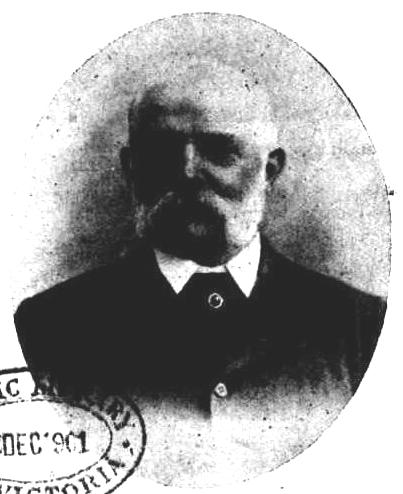 On Thursday Mr
Fairfax became ill, and was attended by Dr Fairfax Ross. Death was due to
uraemia The deceased leaves a widow, four sons (Mr. Alfred Fairfax, of Messrs
Fairfax and Roberts Mr W B Fairfax, Mr Arthur Fairfax, and Mr Frank Fairfax),
and two daughters (Mrs Hetherington, of Queensland, and the other is
unmarried). The funeral will take place at 3.30 o'clock this afternoon, and the
remains will be interred at the Gore Hill Cemetery. DEATH OF MR. ALFRED FAIRFAX.
(1901, November 27). The Sydney Morning Herald (NSW : 1842 -
1954), p. 10. Retrieved from http://nla.gov.au/nla.news-article14425087
On Thursday Mr
Fairfax became ill, and was attended by Dr Fairfax Ross. Death was due to
uraemia The deceased leaves a widow, four sons (Mr. Alfred Fairfax, of Messrs
Fairfax and Roberts Mr W B Fairfax, Mr Arthur Fairfax, and Mr Frank Fairfax),
and two daughters (Mrs Hetherington, of Queensland, and the other is
unmarried). The funeral will take place at 3.30 o'clock this afternoon, and the
remains will be interred at the Gore Hill Cemetery. DEATH OF MR. ALFRED FAIRFAX.
(1901, November 27). The Sydney Morning Herald (NSW : 1842 -
1954), p. 10. Retrieved from http://nla.gov.au/nla.news-article14425087
Mr. Alfred Fairfax
An old identity in the person of Mr. AlfredFairfax, died at his residence,
M'Mahon's Point, North Sydney, at 7.30 a.m. onNovember 26, after a short
illness. The deceased gentleman was 77years of age, and was particularly well
known in aquatic and commercial circles in New South Wales. In the old days he
was vice-commodore of the Royal Yacht Squadron, and was owner of the Magic,
between which yacht and the Mistral many exciting contests were fought out.
Mr.Fairfax also took a prominent part in mining matters at Hawkins Hill, Hill
End, in the eighties, and he was a warm friend of the late Mr. George Thornton.
The late Mr. Fairfax, who was a cousin of Sir James Fairfax, of the "Sydney
Morning Herald," leaves a family of four sons and two daughters, the eldest
of whom is Mr. Fairfax, of the firm of Messrs. Fairfax and Roberts, jewellers,
of Hunter-street. Then there are Mr. W. B. Fairfax, commercial broker, and well
known in cricketing circles; Mr. Arthur Fairfax, and Mr. Frank Fairfax. One
daughter (Mrs. Hetherington) is residing in Brisbane. The deceased gentleman
remained in business as a commercial broker up to the time of his death. Death
of Mr. Alfred Fairfax. (1901, December 7). Australian Town and Country
Journal (Sydney, NSW : 1870 - 1907), p. 37. Retrieved from http://nla.gov.au/nla.news-article71475611
Sydney’ s Old Sailing Days - When the Hon. S. H. Hyam Led the Open Boat Sport: The Genius of Joe Donnelly
(By W. for the Referee.)
In the seventies the late Mr. S. H. Hyam, afterwards the Hon. S. H. Hyam, M.L.C., took the place on the Sydney waters that the Hon. James White held on the Australian Turf in the eighties, the difference being that the Turf man had a chance of recouping his expenses by stakes and wagering, whereas the boating man was all out of pocket, the comparatively small stake-money all going to the professional boat-sailers, and there being no wagering on the events. The principal handlers of the tiller in those early days were George Montgomery, Tom Colebrook, George Fletcher(known later on under his step-father's name of Holmes), and George Ellis. All four were in the Hyam 'stable.' Some idea of the cost of open-boat sailing to Mr. Hyam may be gauged from the fact that he had four crew3 going out from his sheds every Sunday and holiday, and in addition to finding the boats, gear, and entrance fees, he furnished refreshments for the crews, and in no niggardly fashion.
The crack open boat builder of the early seventies ' was Reynolds, of Balmain, to whom Joe Donnelly was apprenticed, the style of centre-board skiff in those days having great rise of floor and narrow tuck, the shape of a peg-top. Reynolds had it all his own way until Joe Donnelly was out of his indentures, when the latter went to Mr. Hyam and said if he would give him an order for a skiff he would turn out a boat to revolutionise open-boat sailing. Of course, Mr. Hyam looked upon Donnelly as a dreamer ; but the young fellow was so persistent that at last he said: 'Well, Donnelly, I'll give you a chance. I'll give an order to Reynolds to build me a19-footer and a 22-footer, and I'll give you a similar order.
THE OLD ORDER CHANGETH.
The orders were placed, and the four skiffs duly made their appearance. Reynolds' were of the old type, with rise of floor and peg-top narrow tuck, whilst Donnelly's were flat in the floor, and carried the beam aft to a broad tuck, the boats being much the shape of a flatiron, by which name Donnelly's 19-footerwas always known amongst boating men. That they should have every chance, Mr. Hyam engaged Montgomery, Ellis, Colebrook, and Fletcher to sail them. From the first it was seen the Donnelly model had come to stay, for the 22-foot skiff, which was called the Ettie, was a marvel both off and on the wind. Montgomery held the tiller in her, and she could rundown to leeward of any 24-footer, and whilst going faster through the water could work up to windward. As regards the two 19-footers, there was not much to choose between them, but I always put that down to the fact that Donnelly's was not built stiff enough. Boat sailers like a boat to 'work,' but it was overdone in the Florrie, as she was called; as when on a wind in a breeze her tuck would be square on the water, while her stem would be over at the usual angle.
TWENTY-FOUR FOOTERS.
No open boat could look at the 22-footer, and Mr. Hyam then looked for other worlds to conquer. Twenty-four footers, or 'fishing boats,' as they were called, were coming into vogue, and Mr.Hyam gave Donnelly an order for a boat of that class. Donnelly, had already built a 24-foot fishing boat of the broadtuck class. If I recollect aright it was the Big Berry, built to the order of Mr. McMurtrie; but when Mr. Hyam's boat came to hand it was the first racing boat of the class, and was called the Lottie. The Lottie won for Mr. Hyam, but it cannot be said she was anything like the success of the skiffs. George Montgomery sailed her in her first race at the Balmain Regatta, and I am never likely to forget it, as I sailed with him. The ninth of November was a calm day, without sufficient wind to take the boats over the- course, which was round the Sow and Pigs, and the race was brought off the following Saturday, when there was no cause to growl about lack of, wind. There were two races held over from Prince of Wales' Birthday, the 23-foot open boats and the 24-footers,both races being started at the one time.
THE WORST BLOW EVER KNOWN.
In all, some 25 boats started in living gale from the south-west, and it may be stated without fear of contradiction that it was the worst blow in which a race was ever started in Port Jackson as of the lot only two — the Lottie and the Young Jim — were able to get round the Sow and Pigs. Amongst the 24-footers were some noted good sea boats, including the Kingfisher, Sea Breeze, and Wyvern; but they all carried away masts or sails, capsized, or ran for shelter. George Ellis in a new 24-tooter, The Duke,' ran into Chowder Bay, and another 24-footer sailed by Griffiths, if I remember aright, hauled her wind round the Sow and Pigs, but capsized off Vaucluse. The Lottie had the throat of the gaff down on the thwart, and was just showing the peak of the mainsail, and even then the men hung out with the ballast, fifty-sixers, held to windward, which would have caused her disqualification had it been known at the time. Strange to say, the Young Jim entered in the 23-f ooter race went through it like a duck, although little better than a bis skiff, whilst the big one simply wallowed in it, the Young Jim beating the big Lottie by an hour or so. Mr. Hyam sold the Lottie to Mr. Sam Macdonnell, and she was a well known boat in Port Jackson for many years after. Donnelly then built the Carlotta for Mr. Hyam, a boat with much greater rise of floor than the Lottie, and she carried all before her. Mr. Hyam then went in for politics, and the Carlotta was the last boat he owned.
THE SAILOR'S BOCABULARY.
Of all the boat sailers of his day, George Montgomery, now dead many years, was acknowledged the best, and he had a vocabulary that would have put the average bullock driver in the shade. A young nephew used to sail with him as bailer-boy, and one day in a big blow, when it was decided to take down a reef, the earring jammed. 'Go out on the mainsheet and clear that earring,' ordered George, but the youngster whimpered, 'It's blowing too hard, whereupon Montgomery, with a volley, told the young 'un he might as well falloff the mainsheet as be thrown over, and he wont. Montgomery knew every trick of tide and slant of wind between Balmain and the buoy at Manly, and I believe he left behind him a chart showing them, but I never heard who got it after his death. Donnelly was undoubtedly a genius in the boat, building line, everything he built being fast, but some of the boat builders of the day were, strange to say, one-boat men, notably Yates, of Woolloomooloo, and Sam Goudd, of Balmain. Yates built the Wyvern for the late Horace Rice, and she proved one of the smartest 24-footers we have seen, whilst Sam Goudd’s Young Jim was the fastest 23-footer of her day, and neither builder turned out another fast boat. Goudd built a 23'footer after the Young Jim to the order of the late Solicitor Creagh, but she proved a failure. Donnelly also proved a great oarsman as well as boat builder, he and Connors being the crack pair-oar team in light skiffs when pair-oar racing was fashionable.
A SENSATIONAL CAPSIZE.
The Wyvern was an actor in one of the most sensational capsizes Port Jackson has seen. I was in the Wyvern, sailed by Tom Colebrook, in a race around the Manly buoy. We were running gaily past Taylor Bay on the return trip with a big square sail set in a black north-easter, when she got her shoulder under and simply settled down. The Sea Breeze, sailed by the well-known fisherman, Sam Richardson, was running behind when she rounded up to our assistance, and getting the sheet on her too quickly, over she went, leaving the best part of forty of us in the water where we remained for a considerate time until seen by the Watsons Bay steamer, which came to our assistance. The nearest approach to a drowning was Mr. Harry Prince, who was hauled aboard by the aid of a boat hook well on the point of collapse.
A Puller Going to Be A Champion
Joe Donnellv also had a big say the 'discovery' of William Beach, who when brought down a green sculler from Dapto went into the stable of Donnelly and Sullivan, who were then boat building at the Glebe. Going into Donnelly's shed one morning I saw a man stripped taking a shower under an improvised bath made out of a kerosene tin with holes punched in the bottom, Donnelly pouring in buckets of water. The man's back was towards me and I thought him the best built man as regards shoulders and 'ribbing up I had ever seen. 'Who's that?' I asked Donnelly. Donnelly, although a very old friend, was ever a taciturn man, and he replied,. 'A puller that's going to be a champion.' That was in the early eighties, and it was not long before Donnelly's prophecy came true, as Beach, in a comparatively short time, beat Hanlan, who, up to that time, was considered unbeatable. Sydney's Old Sailing Days. (1920, December 15). Referee(Sydney, NSW : 1886 - 1939), p. 21. Retrieved from http://nla.gov.au/nla.news-article121158609
The Growth of a Great Pastime! How Yachting has risen in Favor in Sydney Harbor. A man who has grown with it tells the interesting story.
'Sunday Times' Special.
'I am an old identity in the sailing world, but sailing was an established pastime in Sydney Harbor long before my time.' Its growth should provide a good story.’
'Rather!' ~And will you tell it ?'
‘Too big a task for me, I think, but still, I'll try.'
This conversation took place the other Sunday on a harbor beach.
The sailing expert who desires his identity to be concealed was gazing—his eyes
ful of interest — on a fleet of whitewings beating up the Harbor. The 'Sunday
Times' man drew him out, and this is the story of yachting and sailing in Sydney
Harbor as he told it over many pipes of his favorite weed.' Although there are
no authentic records as to the exact date on which my favorite pastime was
inaugurated in New South Wales, it is fairly safe to assume that this form of
recreation was in full swing not long after the hoisting of the British flag on
the shores of Sydney Cove by Captain Phillip. Sailing has always been a popular
British recreation, and here in the new country- Nature had provided a beautiful
playground.
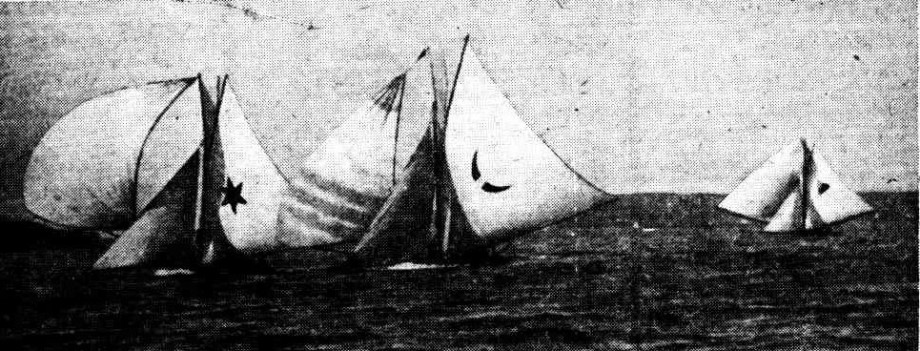
A TYPICAL SYDNEY HARBOR SCENE. THE 18-F00TER IS PERHAPS THE MOST POPULAR
CRAFT IN THESE WATERS.
SYDNEY'S FIRST PLEASURE BOAT.
From sailing traditions, however, I believe that the year 1827 witnessed the first appearance of a sailing vessel constructed purely for pleasure purposes. Mr. Robert Campbell, one of the then leading commercial men of Sydney, was the owner of the craft, which was of three tons, rigged with a sliding mainsail and a jib. Not long afterwards the harbor was graced by the Eclipse — a vessel of six tons, and belonging to a member of the same family. By 1836 the sport had grown to such, an extent as to warrant the holding of a regatta, which event duly took place on the last day of that year. The programme consisted of three races. In the first, there were eight starters, and the race resulted in a rather easy victory for the North Star, owned by Mr. Sawyer, with
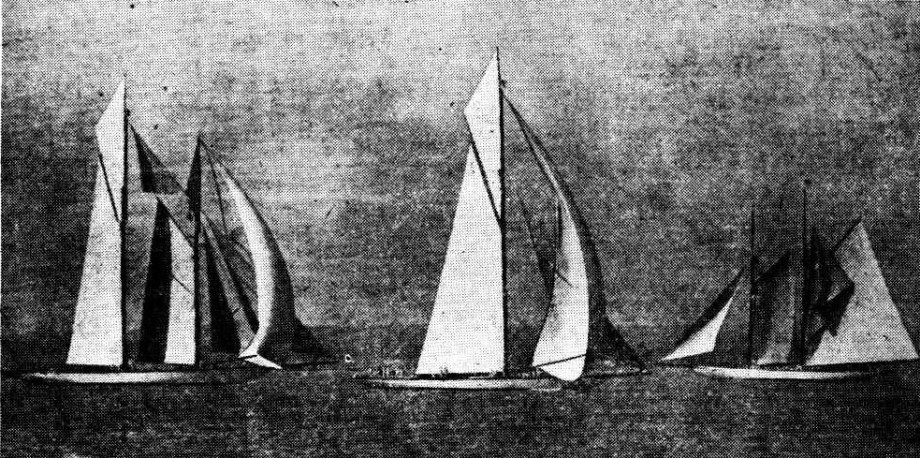
THE WHITE WINGS OF ENGLAND.-SHOWING THE DIFFERENT CLASS OF VESSELS POPULAR THERE— THE SCHOONER AND THE CUTTER.
Mr. Martin's Athol Ranger second. The Seagull, owned by Mr. Gardner, was successful in the second event, and was followed closely by Mr. Moffatt's Aladdin. The third race was for the smaller craft, and was won by the Lion, with the Jane second; but the identity of the owners, of the latter two are unknown.
THE FIRST BOATING CLUB.
In 1836, what is believed to be the first boating club in Australia was started. Mr. Burton Bradley filled the position of Commodore, his flag being flown, at the masthead of the Swallow. The remainder of the fleet consisted of boats owned by Mr. James Milson (Sophia),Mr. John Ritchie (Ariel), Mr. Elyard (Wave),and Mr. George McPherson, the name of whose boat, by the way, is missing from the records which I have. It was in 1837 that the most important event in the boating annuals of Australia took place, for on January 26 of that year, an Anniversary Regatta, was held in Sydney. From 1837 onwards, not a single Anniversary-day has passed without a similar fixture taking place in Sydney.
It was an event which naturally excited the utmost enthusiasm for crowds of eager spectators lined the shores of the Harbor, near Fort Macquarie. Ideal weather prevailed, and— consulting his records — as one scribe, puts it: 'One would hardly think there was an overdue bill in Sydney.' Five races constituted the programme, and in the first-class event, the following participated: Sophia, Mr. Milson; North Star,' Mr. Sawyer; Athol Ranger, Mr. Martin; Jonathan, Mr. Jackson; Arrow, Mr. Stephen; Defiance, Mr. Fisk; Maid of Australia, Mr. Green; Rover, Mr. Lord; and Ranger, Mr. Lockyer (Mayor). After fouling the Ranger, and North Star dead-heated with Sophia, but on the wrong side of the line, and Mr. Milson’s boat was awarded the prize. In the second race the places were filled by Mr. Ritchie's Sea Gull, with the same owner's Nautilus second. As the latter also finished on the wrong side, the prize went to Mr. Henry's Emma. Aladdin, Mr. Moffit's boat, was rundown, it is said, during the earlier portion of the race.
SOME OF THE PIONEERS.
A prominent identity in nautical circles in the early days was the late Mr. George Thornton, who carried off the big race at the Anniversary Regatta of 1839, with the Haidee. This vessel, subsequently sank off. Shark Point and drowned several of her crew. Additional interest was given to yachting in Sydney in 1848 by the late Mr. Richard Hayes Harrnett, owner and skipper of the Madge Wild-fire, who personally designed that remarkable boat; the Australian. In the construction of this vessel which was nicknamed the 'Beaky' or the 'Soda Water Bottle,' Mr. Harnett introduced new ideas. Abandoning all traditions as to the best form of a yacht's hull, he ran a straight edge from keel to water-line, and made all the transverse sections two sides of a triangle. In the longitudinal design he broke away from the straight keel with the deep forefoot, and swept the arc of a circle for the keel, the vessel, which was built at Woolloomooloo Bay by the late Mr. Dan Sheehy.
Some difficulty was experienced in calculating her register, but she ultimately came out as under five tons, and was declared ineligible to go on the squadron's register, boats under this tonnage being debarred. The owner was indignant at this decision, which probably prompted him to take a leading part in later years in the formation of the Prince Alfred Yacht Club. 'In the fifties yachting seems to have attained a position far ahead of the most sanguine anticipations. About this time such men as the late Alfred Fairfax, George Lord, Samuel Hordern, Hon. George Thornton, M.L.C., Hon. H. C. Dangar, and Captain Rowntree were prominently associated with the sport. At the Anniversary Regatta of 1861 Captain Rowntree's Annie Ogle, a boat of nine tons, won a 300 guineas prize, provided by the Sydney Yacht Club, an organisation which had a comparatively short career. The Hon. H. C. Danger was the squadron's first treasurer, and its Commodore from 1867 to 1875. Mr. Charles Parbury also took a great interest in the sport, and from 1867 to 1870 flew the vice commodore's flag. Mr. F. J. Jackson was another enthusiast.
THE AUSTRALIAN YACHT CLUB.
The necessity for a live club became apparent in the early sixties; and at a meeting convened by Mr. William Walker and held at that gentleman's office a club was formed called the Australian Yacht Club. At the next meeting of the club in August, 1862, Mr. James Milson was appointed its first vice-commodore, a post which he held until May, 1867, when he succeeded Mr. Walker as commodore. Mr. Milson was the possessor of a yacht named the Era, a 25 tons vessel, built at Careening Cove. She subsequently became a yacht of Royalty, as the British Government purchased her from Mr. Milson and presented her to King Thakombau of Fiji. In June, 1863, his late Majesty became patron of the club and the word Royal was prefixed to its designation. The yachtsmen of those days evidently showed little inclination to inaugurate many contests, but in January, 1864, a couple of races were provided, trophies of 50 guineas and 25guineas being offered for first and second-class yachts respectively. Xarifa crossed the line first, but was disqualified, the prize going to Era. Why Not, the property of Mr. P. J. Manton, annexed the minor event.
THE FIRST OCEAN RACE.
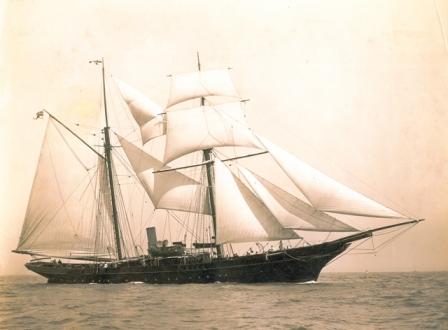 About
this time there occurred the memorable yacht race between the
Xarifa(right) and the Chance. The course was from Sydney to Newcastle
and Back — a distance of 140 miles — and Mr. Walker, owner of Chance staked £100
to Mr. Parbury's £75— amounts which were subsequently increased to £150 and £100
respectively. The Xarifa, by the way, was commonly known as the Rifa. At 1
o'clock on February 14, 1864, the race was started in dirty weather. The wind
maintained its strength throughout the day and the seas increased in proportion.
The Chance had established a good lead, but, at sunset, the Rifa was about nine
miles from Nobbys, the turning point of the race. The little boat was swung
round, and began the perilous voyage back to Sydney. The night was dark and
stormy, and the turbulent sea made matters far from comfortable for both crews.
At about 10 o'clock' that night, when well out to sea, a faint light was
observed to leeward, which turned out to be the Chance. The Rifa, however,
arrived at Sydney Heads' about11 o'clock, and won by a margin of four
hours.
About
this time there occurred the memorable yacht race between the
Xarifa(right) and the Chance. The course was from Sydney to Newcastle
and Back — a distance of 140 miles — and Mr. Walker, owner of Chance staked £100
to Mr. Parbury's £75— amounts which were subsequently increased to £150 and £100
respectively. The Xarifa, by the way, was commonly known as the Rifa. At 1
o'clock on February 14, 1864, the race was started in dirty weather. The wind
maintained its strength throughout the day and the seas increased in proportion.
The Chance had established a good lead, but, at sunset, the Rifa was about nine
miles from Nobbys, the turning point of the race. The little boat was swung
round, and began the perilous voyage back to Sydney. The night was dark and
stormy, and the turbulent sea made matters far from comfortable for both crews.
At about 10 o'clock' that night, when well out to sea, a faint light was
observed to leeward, which turned out to be the Chance. The Rifa, however,
arrived at Sydney Heads' about11 o'clock, and won by a margin of four
hours.
About this time the late Mr. Alexander Oliver joined the ranks of yachtsmen, making his appearance in 1867 with the Vivandiere, a seven tonner. He subsequently became engrossed in deep-sea cruising, and made many interesting voyages in the Possum and Antidote. Early in the seventies the prospects of yachting seem to have improved, for, in 1873, Mr. Alfred Fairfax laid down the keel of the Magic. In the following year there were 15 Vessels on the roll of the Prince Alfred register. The Magic was one of the fastest crafts of her time, and in 1875 was responsible for the big race at the Anniversary Regatta. She continued an unbeaten career until 1887, when she was defeated by the Waitangi.
POPULARITY OF THE R.P.A.Y.C.
The Royal Prince Alfred Club had, up till this time, been content to progress at a steady pace, until the late Mr. J.. Want and Mr. V. Brown were installed as Commodore and secretary respectively, about 1875. Both these were, to a large extent, responsible for the popularity into which the club afterwards grew. A name prominent in yachting race circles was that of the late Dr. Milford, whose vessel, the Doris, was, in 1883, sent to Melbourne to participate in the Intercolonial Regatta held in March of that year. Great difficulties were met with during the run down the coast, but the Doris eventually arrived at her destination. She took part in the third-class event, and won an easy victory. The year 1881 witnessed the first appearance of Messrs. C. W. and T. F. Knox's Sirocco — a vessel which was destined to win many events. The record of winning three regattas in succession— 1882, 1883, and 1884— stands to her credit. A considerable impetus was given to the sport in 1885, by the arrival from England of Mr. Walter Reeks, the well-known naval architect. Almost immediately upon his landing he was consulted by the principal yacht owners, and the result was that a decided improvement in the fleet was witnessed. In 1887 an effort was made by the Victorian yachtsmen to regain the honors carried off by the Doris. A cup, valued at 100. guineas, was offered by Sir William Clarke, of Melbourne, for a series of matches for the premiership of the States. A similar amount was added by the Squadron, and the first event was held on January 15. The race was won by Waitangi. The owner, Mr. Milson, also annexed the second race, held a week later. Not long afterwards, the Era was designed by Mr. Reeks for Mr.Milson, and she started on a successful career. In 1888 she took part in the Intercolonial Regatta in Melbourne, and emerged with triumphant colors.
THE ENORMOUS INCREASE IN SMALLCRAFT.
Since 1888 the growth of yachting in New South Wales, although it has not been phenomenal, has maintained a foremost position in the sporting world. Between 1888 and 1893 there was probably greater interest taken in yachting races, owing to the fact that during this period the vessels engaged were of a larger type than those of the present day. As a result of this there was displayed to view a tremendous amount of canvas, which gave the race additional attractiveness from a spectacular point of view. During recent years, there has been an enormous increase in the number of smaller yachts, and now a larger proportion of the fleet is comprised of the popular 18-footers, skiffs, and dinghies. The coming season promises to be an auspicious one, however, for there is a tendency towards the construction of larger yachts. The acquisition, too, of the Sayonara and the Hurika owned by Messrs. Ross and Dempster respectively, will no doubt cause sportsmen to put renewed vigor into the pastime.'
The Growth of a Great Pastime. (1912, October 13). Sunday Times (Sydney, NSW : 1895 - 1930), p. 23. Retrieved from http://nla.gov.au/nla.news-article120683301
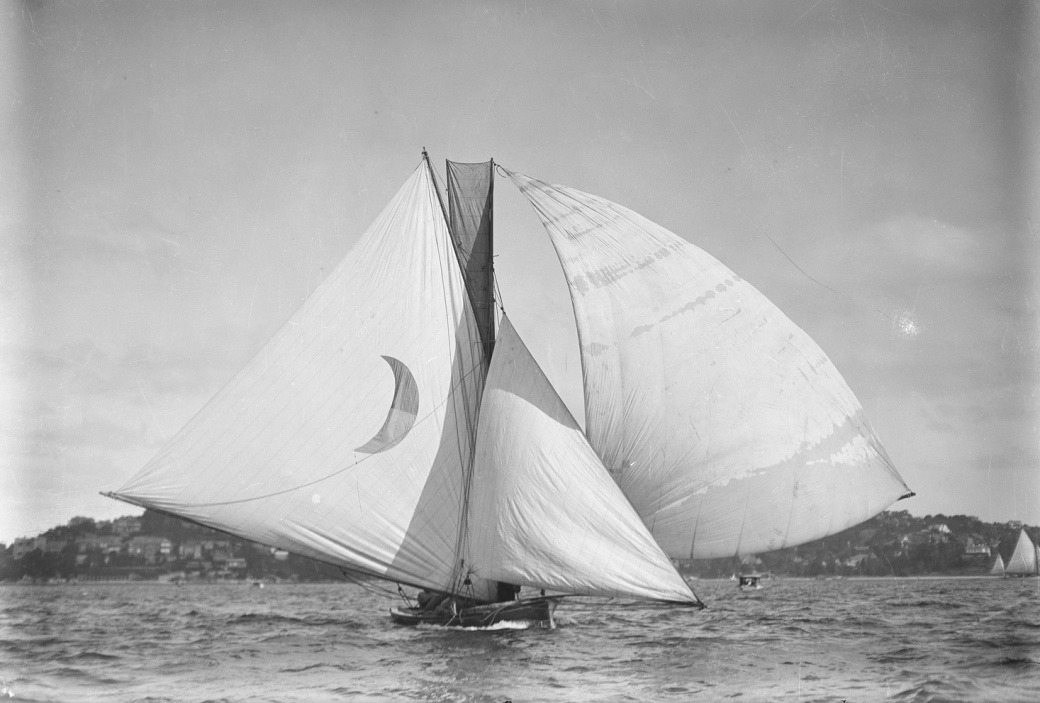
Yacht under sail on Sydney Harbour (the Irex): Object number: 00002630 This photo is part of the Australian National Maritime Museum’s William Hall collection. The Hall collection combines photographs from both William J Hall and his father William Frederick Hall.
THE YACHT RACE - ENGLAND Vs AUSTRALIA
(See letterpress on this page)
A correspondent writes from England as follows: Long before this reaches your readers they will have been informed by cable of the ill success of the Australian yacht Irex, brought over to England by Mr. Mark Foy to try conclusions with the best boat of her dimensions that the skill and experience of England could produce. The challenge was accepted by Mr. W. L. Wyllie, A.R.A., the eminent marine artist and yachtsman of the Medway River, Kent, and a syndicate was formed in Rochester to build a boat fulfilling the requisite conditions. Designed by Messrs. Wyllie and Linton Hope, constructed by Gill and Sons, of Rochester, and christened the Maid of Kent, she has proved herself the lightest and speediest thing of her size that has ever left a boatbuilders stocks. She is 24ft overall, 22ft water line, and 7ft 6in beam. She is very flat on the bottom, with a clean run aft, and her shallow cockpit or sall tank is entirely water tight, and is only on the floor 6in below the gunwales. She is, therefore, a watertight shell, and it is utterly impossible to fill or waterlog her, as all she ships runs out down through the plate slot, and so obviates the necessity of bailing. She has very little freeboard, stability being gained by the great breadth and also by the crew sitting out to windward.
Compared with this wonderfully- built racing ma chine, the Irex appears rather unwieldy and heavy; but as the latter's shape and sailing qualities are familiar to Australians, I shall leave your readers to draw the comparisons of the respective design merits for themselves. She is lug-rigged, and carries spars and rigging of the lightest and strongest character. One of the newest and noticeable features of her rig is the patent ratchet rolling boom, by means of which a reef of any size can be taken in without in the least interfering with the sailing of the boat. She has proved her self very stiff, and carries her sails equally well in a blow or light air, excepting that in à lumpy sea she has a slight tendency to wallow and roll. Her sail area is roughly 600ft, while her opponent, the Irex, carries in a light breeze over 1000. After his challenge had been accepted, and a series of matches arranged, Mr. Mark Foy called a meeting at the Manchester Hotel, London, and selected a crew from a number of Australian yachtsmen at present residing in England. Their names, are as follow:-Messrs. Mark Foy, James Mackin, Jack Gorman, George Holmes, Austin Roderick. Fred Evers, Fred. Tyrrell, Herbert Llewellin, A. G. D'Alpuget, J. Wray, and T. Fitzgerald, of Sydney; M. Montgomerie, Gerald Packer, and Dick Packer, of Hobart, Tasmania, E. G. Murphy, of Melbourne; and W. Wright, of Fiji. A fortnight before the first race a large number of the above-named gentle men became the guests of Mr. Mark Foy at Chatham, at which place constant practice was indulged in, and the Irex 'prepared for the great struggle. Nothing was spared to insure the crew, having ample opportunities for observing the working of the tides and the winds, which in the Medway are extremely strong and tricky, slacks and scours occurring in puzzling profusion. So difficult are they to understand and work that the Irex was compelled to carry in all her races a Medway pilot, whose duty it was to point out the various peculiar movements of the strong ebb and flow which the river sets up.
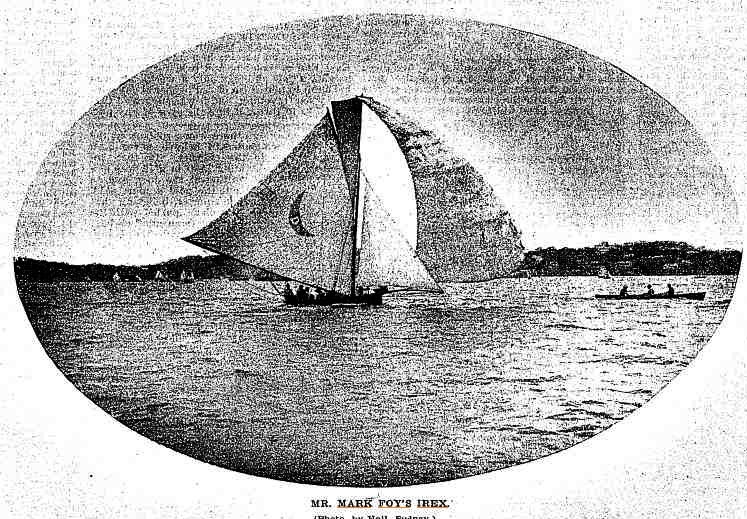
MR. MARK FOY'S IREX. . (Photo, by Hall, Sydney.)
The first of the series of the five matches arranged to be sailed between the Irex and Maid of Kent was decided on September 17, under circumstances which, upon a slack collrae, should have given entire satisfaction to both sides, but it was evident from the gun fire that the Australian boat had a big disadvantage to contend against In having to force her large displacement through a tideway over which the lighter English boat appeared to lift with ease. The Maid of Kent in the end crossed the finishing line 10min 57sec ahead of the Irex.
Although she shipped more water than her Australian rival, her cleverly-designed decking arrangements enabled her to free herself from the seas, which the Irex crew were compelled to laboriously bail out. In the second race, held on September IQ, the conditions were much the same, but this time the Irex, by a series of cleverly-executed manoeuvres, astonished everybody by passing the home buoy the first time round with a lead of 35sec, and this in spite of the fact that she had a short time before passed one of the buoys 1min 48sec after the English boat had rounded it. In the end, however, the Maid of Kent crossed the winning line 8min 39sec ahead of the Irex, although In the run home she so badly strained her deck that she was rendered comparatively sluggish by the quantity of water that she had taken in. The third and last match for the trophy was also won by the Maid of Kent. This time a new course was taken-a run with the incoming tide being given out In consequence of the wind falling, the boats were left to race a strong ebb tide, and the race was given, to the Maid of Kent, she being farthest ahead at call of the race, that arrangement having been agreed to beforehand. The time the Irex was adjudged to be 11mins behind her opponent, but as the river was ebbing strongly the time started cannot be taken as a criterion. Thus the shield goes to the English boat; and until some swifter craft wrests it from her there it will, remain. Mr. Mark Foy, however, a straight and Indomitable sportsman, does not intend to give in, tout is planning future races; in which he hopes to do battle worthily in the name of. Australia. The members of the crew have, during their stay in Kent, been treated with the most lavish hospitality, and will carry back to their southern homes many pleasant remembrances, which will; In a great measure atone for the unsuccessful attempt to lower the colors of their English yachting opponents. It must be mentioned that in the first race the Irex was steered by Mr. Mark Foy. In the second and third Mr. George Holmes, jun., had charge of the tiller.
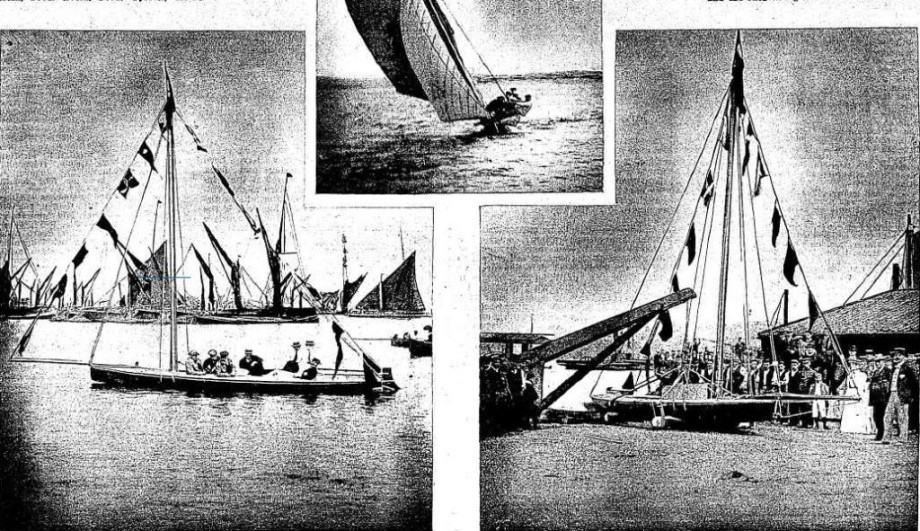
THREE VIEWS OF THE MAID OF KENT. (Photos, by J. J. East mead. Eastgate,
Rochester, England.)
Writing by the following mail, our correspondent says: The Maid of Kent, having beaten the Irex in the three out of the five contests arranged for between Mr. Mark Foy and the Medway Syndicate, it was decided to hold a consolation race, in which Mr. Mark Foy was allowed to pick both the course and direction of tide and time. This race was, as usual, run over a twelve-knot course, the only exception being that the boats were headed in one direction throughout, viz., with the tide; but owing to a late start the race, which should have finished long before the turn of tide, was delayed so much that neither boat was able to- get within a mile and a half of the arranged finishing line. The wind being for the, most part free in this con test, it was thought that the Irex, with her huge spread of sail, which included an enormous spinnaker, would have outclassed her lesser canvassed opponent; but again the great weight of the Irex told heavily against her: as compared to her shallower draught rival. From the start it was clearly seen that the Maid of Kent, although carrying very little more sail off the wind than she had been using when beating, was never in danger of being: overlapped by the Irex. The latter boat, in order to gain what advantage she could from the tide, kept in the centre of the stream throughout the race; while the Maid of Kent, not withstanding the fact that a straight course meant a disadvantage in sailing over slacks in the river, headed a direct course for the finishing steamer. So marked was the difference in the courses sailed by the respective boats that while the Maid of Kent ran from start to finish, without even once throwing her boom over, the Irex, in following the windings of the tide, Jibed no less than five times. Every time this course was adopted the Irex crew were compelled to lift and lower her huge centre plate, to the no small diminution of her speed. In the end, the wind having completely died away, the Maid of Kent was adjudged to be seven minutes ahead of Mr. Foy's boat, although, as previously stated, neither of the boats reached the winning post, the tide having turned some half-an hour before gun-fire. It is now generally admitted by all who saw the races, and have watched the sailing points of the two, that In a tidal river, boats of the Irex design have no chance of competing with the type of lightly-built shells of which the Maid of Kent is a representative. Again, while the top hamper of the Maid of Kent has been reduced to the uttermost consistent with strength, that or the Irex has been proved to be a burden and an impediment to her sailing qualities.
These, and many other defects, such as excessive weight and draught, will need to be rectified before Australia can hope to successfully compete with boats of the Maid of Kent class. On the Saturday evening following the races, the Medway Yacht Club entertained Mr. Mark. Foy and his crew at dinner, and on Sunday they were the guests of Mr. and Mrs. Wyllie. On the Monday, a small regatta was held, in which six boats of the 18foot class were entered, and it is pleasant to record that the popular skipper of the Irex, Mr. Mark Foy, had the honor of steering to victory the winning boat, although the remaining five were piloted by the most skilful yachtsmen of the Med way. Altogether the races have been sailed under the most pleasant auspices, and the different visitors from Australia will have no occasion to regret their visit to Kentish waters.
Perhaps no boat of her class was better known in Sydney than the famous 22-footer Irex, which achieved so many successes when owned by Mr. A. Kinninmont. The Irex was built by Donnelly about twelve years ago, and since her launch she has secured wins and places with wonderful consistency, and as a representative of New South Wales she brought back the City of Brisbane Club's 22-foot Championship, about two years ago. In all round sailing, the Irex had very few equals. According to the London papers, Mr. Foy was at the tiller on all three contests with the "Maid of Kent." Mr. Foy is not considered exactly an expert at the tiller, but he deserves well of our boating community, in having arranged these contests, and It will be surprising if they do not lead to some more important international events in the future. THE YACHT RACE, ENGLAND v. AUSTRALIA. (1898, November 12). Australian Town and Country Journal (Sydney, NSW : 1870 - 1907), p. 19. Retrieved from http://nla.gov.au/nla.news-article71320286
YACHTING. MR. MARK FOY BANQUETED. LONDON, September 26.
The Sydney yachtsman, Mr. Mark Foy, whose boat, the Irex, was recently defeated by the Medway Yacht Club's craft The Maid of Kent in a series of races has, with the crew of the Irex, been banqueted.
The banquet was tendered to Mr. Mark Foy and his crew at Chatham by the Medway Yacht Club. Replying to a complimentary toast, Mr.Foy, in admitting that the Irex was fairly beaten in the recent contests, said that the light draught and displacement of the English yachts had been a revelation to him. He, however, was of the opinion that the Irex type of boat was the best suited for racing in slack waters. Mr. Foy further re-marked that Australians, having learnt a lesson as the result of the races in which his boat had suffered defeat, would profit thereby, and at some later date challenge an English representative yacht club again. YACHTING. (1898, September 28). The West Australian (Perth, WA : 1879 - 1954), p. 5. Retrieved from http://nla.gov.au/nla.news-article3213225
SYDNEY'S HARBOR FLYERS SPREAD THEIR SAILS
Opening Event of Sailing Season Goes to Thompson's 'N.S.W.'. PATRON MARK FOY'S RECORD
(By 'OLD NICK')
It was a real sailor's day on Sydney Harbor on Saturday— a strong breeze, a fast ebbing tide, and a comforting springtime sun. The conditions just suited the two dozen 18-fouters that were blown down to Clark Island to take part in Sydney Flying Squadron's opening race of the season. The State Governor went to the mark on Mr. McEvoy's motor cruiser to start the event, and the evergreen Judge Backhouse was with him.
NOTWITHSTANDING the force of the nor'-easter that came up the
harbor and fought the outgoing tide for supremacy, all the boats carried big
sheets. Some carried them all the way, some didn't. Arline turned over at
Bradley's, while Kismet also struck trouble. Desdemona started half-a-minute
ahead of the next boat and stayed in front of the three on scratch. Her
owner-skipper, A. C. Roberts, took her away to the front and she stayed there
for quite a long time. She might have stayed there throughout the journey had
she not made what seemed to be an unnecessarily protracted board to round the
Taylor Bay mark. N.S.W. which for some time had been threatening her, beat her
to the lag. After that the race was never in doubt. N.S.W. sailed beautifully.
Her skipper, H. E. Thompson, never made a mistake, and he got his charge over
the line about 45 seconds ahead of Dessy. Cutty Sark plugged her way into third
place. Eclipse II, Keriki, and Furious made mistakes, and were ordered to drop
out. The two large ferry boats that followed the race were crowded with sailing
enthusiasts. Many old-timers were among the spectators, and the officials expect
that the fortieth year of the squadron's existence will be a record one in point
of popularity and finance.
Mr. Mark Foy founded the S.F. S. 30 years ago, and at the
election of officials for the 1931-32 season last week, Mr. Foy was again
elected patron. He has always held the opinion that the 18footers give the best
opportunities for scientific handling, and provide the most spectacular form of
yachting. Everyone on the harbor on Saturday last agreed with him. In 1897
the officers of the S.F.S. were: Commodore, Mr. Mark Foy; vice commodore,
Alex Kinnimont; Hon, sec, George Drew; hon. treasurer, George Collins; trustees.
F. J. Donovan, H. Maxwell, A. E. G. Thomas; handicapper and timekeeper, F. J.
Donovan; umpire, G. Drew; starter and judge, Chas. Messenger. The 18-footers
then racing were: Stella II (G. Ellis), Australian(Chris Webb), Cygnet (P.
Pontey);Yvonne (W. Gokling-). These competed with 22 and 21-footers. George
Holmes sailed a 20-footer, Victor, and the 22-footers were Effie (Jim
McMurtrie), Vigilant (Billy Pead), Irex (W. Holmes), Gladys (Tom
Colebrook),Willia (Herb. Maxwell), Flying Fish(A. E. G. Thomas), Figtree (Jack
Robinson), and Ellie (W. Maidment).Jim Busch skippered the 24-ft Lottie.
Up to 1925 the Sydney Sailing Club carried on in friendly rivalry with the S.F.S. Then they amalgamated in the interests of the sport. For 15 years 18-footer racing were confined to New South Wales as a recognised aquatic sport. Then It spread to other States, and 21 years ago the first interstate race took place at Perth in conjunction with the Perth Flying Squadron and the Mounts Bay Sailing Club of Western Australia. From that time to the present day Chris Webb has been right out in front as a shipper, and he is still probably the most skilful skipper on the harbor, or for that matter In the whole of Australia, he has won seven blue ribbon Australian championships, his closest rivals being Colon Clark (Brisbane), and Chriss Garland (Perth), with two wins each. In 1900-7 Perth Flying Squadron's Challenge Cup was won by the Western Australian boat, Aeolus, sailed by T. Tomlinson, at Perth, but in the three succeeding years Chris Webb established a mortgage on It, winning it once In Perth und twice In Sydney, each time in the 18-footer Australian. Queenslanders made their first appearance in interstate racing In the Mark' Foy Challenge Cup In 1913-14.In the competitions for this trophy, Chris Webb won four times In five starts in 11 years, each time with George C. Press' boat, H. C Press. At the conclusion of the 1927 carnival the cup was handed over, to Mr. George Press at the suggestion of Mr. Mark Foy. The veteran did not take part in the racing on Saturday last, but when he comes, into the picture' later on In the season, his wonderful skill as a skipper and his fine judgment In the matter of winds und tides will cause him to be regarded with respect by all opponents. SYDNEY'S HARBOR FLYERS SPREAD THEIR SAILS. (1931, September 23). Referee (Sydney, NSW : 1886 - 1939), p. 20. Retrieved from http://nla.gov.au/nla.news-article136745255

FIG TREE and VIGILANT on Sydney Harbour, 1897 Intercolonial Races, Object number 00013882, courtesy Australian National Maritime Museum.
The Intercolonial Sailing - Carnival at Sydney.
(See Illustrations on next page.)
The Intercolonial Sailing Carnival at Sydney was brought to a close on Saturday last, when a race for l8-footers and one for 22-footers was sailed. As will be seen by our sporting columns, the prizes in each event were secured by Sydney bouts. The carnival all through has produced excellent sport, and the management of the whole carnival reflects great credit on all concerned. The success of this carnival augurs well for future events of the kind, public interest in the races being very great. This week we give pictures of the Vigilant (N.S.W.), built by Golding, and sailed by W. Read, which won third prize in the Intercolonial 22ft Championship Race on January 23, and second prize in the Intercolonial 22ft Challenge Race at the Anniversary Regatta; Fig Tree (N.S.W.), owned and built by R. Stevens, sailed by Chris. Webb, second in the Intercolonial 21ft Championship; Britannia (Queensland), owned by H. Anderson and sailed by A. Earle, winner of second prize in the Intercolonial 18ft Championship Race on January 28; lrex (N.S.W.), owned by A. Kinnimont, built by Donnelly, and sailed by Fred. Doran, winner of the Intercolonial 22ft Championship on January 21; Vera (Queensland), owned by J. ll. Whereat and sailed by S. Sandberg; Thalia (N.S.W.), owned by E. S. Abraham and sailed by W. Read, winner of the Intercolonial 18ft Challenge Race at the Anniversary Regatta and the Intercolonial 18ft Race on January 30. By his second win in the Thalia of the 18ft class, and securing a second and third place in the Vigilant in the 22ft races, W. Read is entitled to the prize of ten pounds) given by the Four-Crown Whisky representatives to the most successful skipper in the carnival.
Among our pictures is a view of the French mail steamer Polynesien, the flagship at the Anniversary Regatta. This line vessel was courteously placed at the disposal of the regatta committee by the Mearageries Maritimers, and she proved almost as great an attraction for the visitors as the racing itself. Commander Boulard had the crack liner in line trim, and both he and his officers spared no exertion to ensure the comfort of visitors to the flagship.
On page 29
THE INTERCOLONIAL SAILING CARNIVAL AT SYDNEY.
M.M. Company's s.s. Polynesien (Commander Boulard), Flagship, Anniversary Regatta, Sydney, January 26. Tonnage, 6562; Length, 501 feet; Horse-power, 7000.
(Photo, by Falk, Sydney.)
Some of the Competitors.
1 . Vigilant and Fig Tree. 2. The Britannia (Queensland). 3. The Irex (winner Intercolonial 22ft Championship on January). . .4. The Vera (Queensland). 5. The Thalia (winner Intercolonial 18ft Challenge Race, Anniversary Regatta, and Intercolonial Skiff Race on January 30).(From Photographs by Hall, Hunter-street, Sydney.) - (See letterpress on. previous page.) .
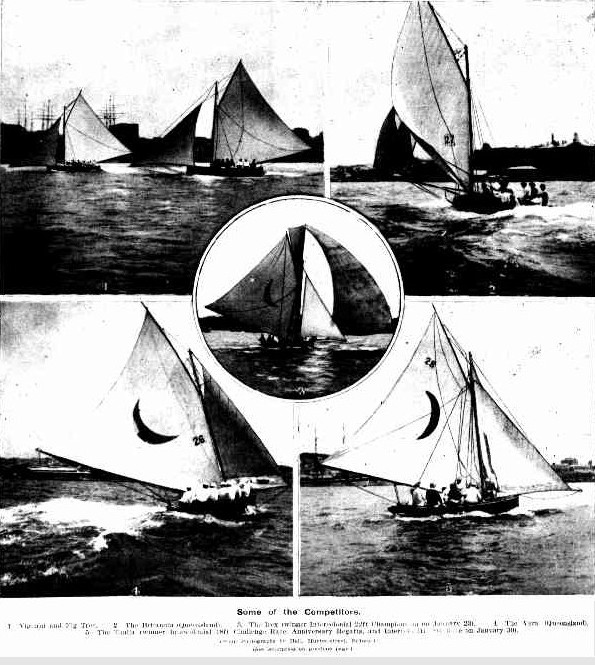
The Intercolonial Sailing Carnival at Sydney. (1897, February 6). Australian Town and Country Journal (Sydney, NSW : 1870 - 1907), p. 28. Retrieved from http://nla.gov.au/nla.news-article71289648